“Acting

Emotional Intelligence: The Secret to Happiness?
READER’S DIGEST | SMALL AND PERFECTLY INFORMED | OCTOBER 2017 HEALTH • MONEY • TRAVEL • RECIPES • FASHION • TECHNOLOGY OCTOBER 2017 £3.79 readersdigest.co.uk OCTOBER 2017
Can Feel Quite Lonely”
PAGE 74 PAGE 36
PAGE 20
Emily Mortimer:
Ways To Live Longer 7




























Meet the family who prove a diagnosis of autism doesn’t have to spell disaster
66 BEST OF BRITISH: HALLOWEEN
Discover the best places for a spooky adventure

74
Why emotional intelligence is more important than IQ
84 PHOTO COMPETITION WINNERS
See the snaps that beat hundreds to the top spots! Travel & Adventure
90 BEHIND PALACE DOORS
Experience regal life in India’s Rajasthan region
104 MAROONED WITH POLAR BEARS
A pilot is stranded in the Arctic Circle—can he survive?
COVER PHOTOGRAPH: JARED SISKIN/GETTY IMAGES 10•2017 | 1 Contents OCTOBER 2017 FEATURES
completing his tax return Entertainment
EMILY
INTERVIEW
12 IT’S A MANN’S WORLD Olly Mann delights in
20
MORTIMER
love of roast dinners
“I
RICHARD
The actress opens up about self-doubt, motherhood and her
28
REMEMBER”: REVEREND
COLES
The musician and priest on finding peace Health
36 DO YOU WANT TO LIVE FOREVER? Uncovering the technology that could increase lifespan Inspire
54 A TALE OF THREE MAGICAL CHILDREN
CHOOSE THE PATH TO A HAPPY LIFE
p74 THOMAS BARWICK/GETTY IMAGES
EDITOR’S LETTER

HOW DO YOU DEFINE HAPPINESS? It’s a question that permeates our features this month. Many people—especially today’s younger generations—think that success and fame are the answer, but on p28 Reverend Richard Coles reveals how swapping show business for a quieter life in the priesthood brought him greater contentment.
Others think that a long life is a sign of a happy existence, and we explore the ever-developing reality of this in “Do You Want To Live Forever?” Far from being the ultimate goal, could longer lives bring greater discord and inequality? Turn to p36 and see what you think.
Health, of course, contributes to happiness—but not always in the way you’d imagine. On p54 we meet a remarkable family with three autistic children, and learn how their mental, physical and emotional struggles have paved the way for a richer life.
I hope that these features, along with the rest of the issue, bring you some happiness this month.
 Fiona Hicks
Fiona Hicks
| 10•2017 2 IN EVERY ISSUE 6 Over to You 8 See the World Differently Entertainment 17 October’s cultural highlights Health 44 Advice: Susannah Hickling 48 The Nutrition Connection 50 Column: Dr Max Pemberton Inspire 64 If I Ruled the World: Johanna Basford Travel & Adventure 100 Column: Cathy Adams Money 110 Column: Andy Webb Food & Drink 114 Tasty recipes and ideas from Rachel Walker Home & Garden 118 Column: Lynda Clark Technology 120 Olly Mann’s gadgets Fashion & Beauty 122 Georgina Yates on how to look your best Books 124 October Fiction: James Walton’s recommended reads 129 Books That Changed My Life: Anthony Horowitz Fun & Games 130 You Couldn’t Make It Up 133 Word Power 136 Brain Teasers 140 Laugh! 143 60-Second Stand-Up: Milton Jones 144 Beat the Cartoonist
Reader’s Digest is published in 27 editions in 11 languages
theeditor@readersdigest.co.uk facebook.com/readersdigestuk twitter.com/readersdigestuk









EDITOR-IN-CHIEF Fiona Hicks
ASSOCIATE EDITOR Anna Walker
CULTURE EDITOR
Eva Mackevic
All commercial services provided by: SUBSTANTIVE MEDIA LTD 0203 795 8886
ADVERTISING
Mike Allen | mike.allen@readersdigest.co.uk
Kerry Schofield | kerry.schofield@readersdigest.co.uk
Sarah Hughes | sarah.hughes@substantivemedia.com
ART EDITOR Richard Cooke
GENERAL MANAGER Gavin Suen
TRUSTED MEDIA BRANDS INC (USA)
President and Chief Executive Officer
Bonnie Kintzer
Vice President, Chief Operating Officer, International Brian Kennedy
Editor-in-Chief, International Magazines
Raimo Moysa
WE PAY...
£50 for the star letter and £30 for regular letters.
Email readersletters@readers digest.co.uk or go to readers digest.co.uk/contact-us
WE ALSO PAY...
£50 for the true stories, anecdotes, jokes in Laugh! and You Couldn’t Make It Up…, and contributions to end-ofarticle fillers and My Great Escape
Email excerpts@readersdigest.co.uk or go to readersdigest.co.uk/contact-us
SORRY!
We cannot acknowledge or return unpublished items or unsolicited article-length manuscripts. Do not send SAEs. Article-length stories, poetry and cartoons are not requested.
CUSTOMER SERVICES
Contact Customer Services for renewals, gifts, address changes, payments, account information and all other enquiries. Call 0330 333 2220* or email customer_service@readersdigest.co.uk
TALKING MAGAZINES
Reader’s Digest is also available in audio and accessible etext editions from RNIB Newsagent, for blind and partially sighted readers. Call the RNIB Helpline on 0303 123 9999 or visit rnib.org.uk/newsagent
SUBSCRIPTIONS
Visit readersdigest.co.uk or write to: Reader’s Digest, PO Box 7853, Ringwood BH24 9FH. UK: £45.48 a year. Republic of Ireland: €61.20 a year. Prices include delivery. For gift subscriptions, contact Customer Services.
4 | 10•2017 *Calls to 03 numbers cost no more than a national rate call to an 01 or 02 number and will be free if you have inclusive minutes from any type of line including mobile, BT or other fixed line PAPER FROM SUSTAINABLE FORESTS. PLEASE RECYCLE © 2016 Vivat Direct Ltd (t/a Reader’s Digest). British Reader’s Digest is published by Vivat Direct Ltd, 57 Margaret Street, London W1W 8SJ. All rights reserved throughout the world. Reproduction in any manner, in whole or part, in English or other languages, is prohibited. Reader’s Digest is a trademark owned and under license from Trusted Media Brands, Inc, and is registered with the United States Patent and Trademark Office. All rights reserved. Printed by Pindar Scarborough Limited. Newstrade distribution by Seymour Distribution Limited. SMALL PRINT: Ensure submissions are not previously published. Include your name, email, address and daytime phone number with all correspondence. We may edit letters and use them in all print and electronic media. Contributions used become world copyright of Vivat Direct Ltd (t/a Reader’s Digest). Reader’s Digest is a member of the Independent Press Standards Organisation (which regulates the UK’s magazine and newspaper industry). We abide by the Editors’ Code of Practice and are committed to upholding the highest standards of journalism. If you think that we have not met those standards, please contact 0203 289 0940. If we are unable to resolve your complaint, or if you would like more information about IPSO or the Editors’ Code, contact IPSO on 0300 123 2220 or visit ipso.co.uk
TO US! SEND US YOUR STORIES, JOKES AND LETTERS OR VISIT OUR WEBSITE
For all subscriber enquiries, please use the customer services number below WRITE

A fright-night feast
Now that Halloween season is here, there’s a good chance you’ll soon have some pint-sized visitors at your door hoping for treats. We’ve got recipes for some spooky Halloween treats that are so delicious, the big kids in your life will love them too…Visit readersdigest.co.uk/halloween-treats for all the recipes.
Autumn in the garden
As summer draws to a close, we’ve written a 38point checklist to make sure you don’t forget any of those all-important autumn garden jobs. From netting your pond to draining your hosepipe to protect from frost, there’s bound to be something that’s slipped your mind. Visit readersdigest.co.uk/autumn-garden

twitter.com/readersdigestuk







facebook.com/readersdigestuk
See more adorable animals dressed up at readersdigest.co.uk/ halloween-animals
5 10•2017 |
FOR MORE, GO TO READERSDIGEST.CO.UK
PUTTING THE “PET” IN PETRIFYING readersdigest.co.uk
© SHUTTERSTOCK
Over to You
LETTERS ON THE AUGUST ISSUE
We pay £50 for Letter of the Month and £30 for all others
✯ LETTER OF THE MONTH...
I read Olly Mann’s article “A Memorable Occasion” with interest. Isn’t it a shame that we’ve become so obsessed with celebrity that even the most excellent sentiment is considered less valid if it wasn’t uttered by somebody adequately famous? That “guy you’ve never heard of” made a very good point in saying, “Be nice to nerds. Chances are you’ll end up working for one.” In fact, had it really been Bill Gates who had said it, I think it might have sounded rather conceited.

Nevertheless, Olly’s predicament does highlight a common problem with social media: we ought not assume that everything we see on it is true. Having been caught out once or twice by “fake news”, I’m now very careful to check the accuracy of any quotation before I hit “share”.
AYE, AYE, MATEY
In “Top Trivia”, it was fascinating to learn that pirates wore eye patches so one eye would always be acclimatised to the dark. I’d always assumed that the patch was probably one of those accessories that originated with Robert Louis Stevenson’s Treasure Island. It never
MARY MOORE, Milton Keynes
ceases to amaze me just how many urban myths we assume to be castiron facts, and vice versa.
All we need now is for pirates to come clean about what nefarious use they may have had for those wooden legs and parrots. If only we had Blackbeard’s email address!
PHILLIP BROWN, Staffordshire
PHOTO/ILLUSTRATION CREDIT | 10•2017 6
NO CARS? CRAZY
Matt Haig’s comment in “If I Ruled the World” that there should be a blanket ban on cars has left me feeling disgruntled. While I agree that cars should be banned from cities and larger towns with good transport links, there are many people who cannot get by without them.
I live in an area with poor transport links. It’s a mile to the nearest bus stop and the nearest train station. With two young children (one of whom suffers with low muscle tone and hypermobility of the joints) to get to school, I’d be in dire straits without a car. Many parents of children with additional needs and/or disability would be isolated without cars. Please don’t take away our lifeline!
Families should only be allowed cars if there’s a genuine need. Everyone else can walk.
JANE GILL, Surrey
In “If I Ruled the World”, Matt Haig wants to ban cars—but he must have said this tongue in cheek.
He reckons it would be healthier to use our legs. By getting soaked in the rain struggling up a steep hill? Or by navigating icy footpaths?
Admittedly without a vehicle one
would be better off financially and could use the garage for storage. But what a dreary life it would be without drives in the country and visits to friends. Not all of us have access to a bus or a train.
Is he willing to walk the kids to school? Carry the shopping home? Commute by foot?
Let Matt try living without his car for a month. Bet he’d soon be back on the road!
SHEILA CHISNALL, Devon
CARRY ON, JOAN
Thank you for your fabulous interview with Dame Joan Collins, “I Do What I Like”!
The veteran actress has endured her fair share of both good and bad press in the six decades that she’s been in show business. However, she’s never complained and just gets on with things in her own inimitable fashion. I echo her attitude: “I just enjoy life”!
Even though many people will remember her as the glamorous Alexis in Dynasty, my favourite Joan moments were in the Cinzano television adverts of the late 1970s— when she was the butt of Leonard Rossiter’s jokes! Keep it up, Joan.
MELANIE LODGE, West Yorkshire
10•2017 | 7
WE WANT TO HEAR FROM YOU! Send letters to readersletters@readersdigest.co.uk Please include your full name, address, email and daytime phone number. We may edit letters and use them in all print and electronic media.

PHotos: © VCG V ia Getty i ma G es

world
the page
see the
turn


...differently
the fluffiest photo shoot in the world took place in China last september, when the Chengdu Research Base of Giant Panda Breeding presented a group of 23 bear cubs to the public. these cute little bears are raised to help prevent the overall extinction of pandas. the programme began in 1987 with only six bears—today there are more than 50.
Unfortunately, the majority of these cuddly critters can never be set free, as close contact with humans leaves them unprepared for a life in the wild.
11
Somewhat surprisingly, Olly Mann revels in totting up his financial year
Straight To The (Decimal) Point

Olly Mann is a writer, radio presenter and serial podcaster, with shows including Answer Me This!, The Media Podcast and The Modern Mann
TIME TO DO MY TAX RETURN. I wouldn’t exactly say I’m excited. But it’s such a change of pace from my usual daily existence that I actually rather enjoy a day or two of filing, and counting, and poring over remittance slips. Is that so wrong?
Nostalgia plays a role. Until I became self-employed, I never knew a simple McDonald’s receipt, for instance, could evoke such a vivid trip down memory lane. It’s not just the stirring physical memory of the strawberry milkshake cooling my throat down on a hot summer’s afternoon. Equally redolent is the address of the branch (I’d forgotten I spent that morning in Northampton! Do you remember, there was a Sally Army band playing outside…), the name of the woman who served me (Denise, that’s right! She had that chunky bracelet), and even the precise time that the milkshake was served (3.34pm? A bit early for milkshake. Oh yes, that’s right, I had that hairdresser’s appointment at 4pm…). Thanks to my anal process of filing away every single receipt, regardless of its value, a whole year of forgotten afternoons comes sharply into focus.
THERE’S ALSO, OF COURSE, THE SATISFACTION of claiming back some money. I was in Northampton that afternoon to host a show on their local radio station. Then I had a haircut for a photo shoot the following day. So, that was a Work
| 10•2017 12
IT’S A MANN’S WORLD
 BY DAN MITCHELL
BY DAN MITCHELL
Milkshake, that was. Drinking strawberry milkshake is part of my job. Take that, Mr Taxman!
Now, claiming a tax discount on strawberry milkshake seems absurd. But by applying the relevant rules, it
is also entirely logical. Look, I believe in paying my taxes—that’s how pensions get paid and children get educated. But I also enjoy the merry dance of calculating exactly how much I owe. See, it’s fun!
READER’S DIGEST 10•2017 | 13 ILLUSTRATION
It’s even more entertaining because I refuse to use proper accountancy software to log my payments and invoices. I’m aware that to do so would be more efficient and more readily understood by my accountant. But I have my own, bespoke, colour-coded document I dreamed up years ago: yellow for TV appearances, green for voice-overs, blue for corporate work, red for radio— and it’s just a lot more engaging to complete a log of my work when it looks like a multicoloured rainbow of achievement, rather than a sad old blackand-white spreadsheet of underpaid gigs and decimal points.
Having always been hopeless at budgeting—so long as bills get paid, I rarely obsess about my income—I usually only discover how much I actually earned in any given month when I complete my coloured spreadsheet the following year. Totting up each month’s figures, therefore, is full of suspense. In my head I’m playing an ITV daytime quiz show, in which I have to guess whether my July 2016 figure will be higher or lower than my July 2015 figure. (It was higher! Well done, Olly!! You’re through to
the next round!!!). Basically, I’ve gamified data entry.
It’s just a lot more engaging to complete a log of my work when it looks like a muticoloured rainbow of achievement
I also use eye-catching stationary to lift my mood. It’s a shame, really, that professional number-crunchers do so much jotting, blotting and totting that they burn through pencils on an hourly basis and find themselves buying replacements from wholesale stationers, where every item is dull. By contrast, as a hobbyist desk bunny, I can and do buy paperclips in the shape of emojis, erasers that look like dog turds and highlighters that are so brightly neon they burn your retinas. I still use the baby blue Casio calculator that I had in GCSE Maths, emblazoned with my name in Tipp-Ex. It’s hard to be bored.
THEN THERE’S THE UNBRIDLED JOY of chasing up outstanding fee payments. I realise that sounds like sarcasm, but I mean it. If I follow an invoice up within a few months of it being submitted, I always feel acutely embarrassed; somehow vulgar for bringing up such a déclassé topic as actually being paid for the work I’ve done (“I’m terribly sorry, I’m sure it’s on its way, but would you possibly mind
IT’S A MANN’S WORLD | 10•2017 14
checking for me that you’ve processed my invoice?”—that kind of hogwash). But, one calendar year later, it’s beyond any doubt who’s in the wrong: they’ve had AGES to pay me, and despite my repeated chasing, they have failed. This puts me in the driver’s seat. I get to call up and be the victim, and they’re usually terribly apologetic.
Genuinely, it’s quite a nice feeling to suddenly feel like I’m a priority for them.
Plus, if you wait a whole year to chase an invoice, you get paid pretty promptly. I imagine that’s not the sort of advice that would appear on any accountancy course. But, sometimes, we amateurs can teach the pros a thing or two. Bring on 2018.
FAKE FACTS
Twitter is ablaze with falsehoods about our fair nation, thanks to the hashtag #AwfullyBritishFakeFacts. See if you can fool your friends with any of the below:
“It takes 30,000 litres of paint and five months to complete painting the White Cliffs of Dover.”
“A Brexit is when you exit a restaurant without paying for your breakfast.”
“There are more cups of tea in Britain than people.”
“It’s mandatory to learn how to queue, otherwise you’ll fail your GCSEs.”
“All British-born children must be proficient with a kettle and teaspoon by the age of one, or face abandonment.”
“Approximately 500,000 tourists die each year after failing to mind the gap between the train and the platform.”
“The English Civil War was actually about whether you add milk first or after the tea.”
“There are only two positions in the UK’s Kama Sutra: missionary with socks and missionary without socks.”
SOURCE: THEPOKE.CO.UK
READER’S DIGEST
10•2017 | 15





























The latest addition to the Gtech garden power tools range is a lightweight yet powerful cordless Leaf Blower.

This autumn make short work of clearing leaves and garden debris.
High Performance
The 36V Lithium-ion Gtech Leaf Blower has the ability to clear debris from your lawn, patio and driveway. Using a turbo fan design that allows for a straight air passage from intake to outlet, offering maximum air ow and ef ciency that spins the fan at 11,500 times a minute*.
Complete control
The Leaf Blower is lightweight, at just 4.3 kg, the product has been designed so that battery and body weight are evenly distributed. When in use, it will naturally point towards the ground to direct air ow. So, you won’t have to worry about straining your wrists, even if you use it for the entire 20-minute runtime on full power. The variable trigger allows for complete control, when you squeeze or release the trigger you will feel the air ow change to suit your garden needs.







Easy to use
The Gtech Cordless Leaf Blower is easy to use, there is no need to pull cords or top up with fuel, simply attach the battery and pull the trigger to start. The product’s cordless convenience means there are no cables to trip you up or limit your access, and no petrol to store or pour – simply charge and it’s ready to go. When you’re done, you can remove the detachable nozzle, so the Gtech Leaf blower is compact enough to be stored in small places.



Don’t just take our word for it… We really do care what you think. Go online to see the thousands of independent reviews our customers have given us; and check out our product videos at www.gtech.co.uk


* +/- 5% spin rate. See www.gtech.co.uk for full details. CPN1871 Over 30,000 independent reviews ORDER DIRECT - £285.99 with FREE DELIVERY 0800 051 83 53 (24 hour orderline) www.gtech.co.uk (easy online ordering) Up to 20 minutes run-time
Powerful 36V motor Introducing our new powerful cordless Leaf Blower.
Films
by e va mackevic Movie of the Month
■ comedy the death of stalin “Keep your friends close, and your enemies closer” is the main lesson of The Death of Stalin. Except that, in Soviet Russia, you never really know who your friends are. This hilarious satire from comedy genius Armando Iannucci follows the final days of Joseph Stalin and the cut-throat fight for power that ensues after his death. Soviet officials speak with Cockney and New York accents, proclamations of love for the fatherland are the core of every conversation and casual executions punctuate them like commas. Starring Steve Buscemi, Jason Isaacs, Rupert Friend and many others, it’s a brash, grotesque and hilarious history lesson with non-stop gags flying at you like a Stalinist fist.
■ sci-fi: blade runner 2049 In this sequel to the 1982 cult classic, a young blade runner, LAPD Officer K (Ryan Gosling), unearths a dangerous secret that threatens to destroy what’s left of society. This discovery takes him on a quest to find the former blade runner Rick Deckard (Harrison Ford) who’s been missing for 30 years. Featuring a superb supporting cast, chilling dystopian visuals and a score you won’t forget.


■ biography: breathe
At 28, Robin Cavendish was paralysed from the neck down due to polio. Despite being given only a few months to live, he survived for another 36 years, becoming a prominent advocate for the disabled. Although a truly remarkable story, the film’s efforts to bring out the characters’ emotional nuances fall short. Still, Andrew Garfield makes Breathe worth seeing—his impish, utterly lovable facial expressions are worthy of an Oscar nod.

entertainment 10•2017 | 17 © entertainment one/sony pictures/stx entertainment
Jason Isaacs stars as Georgy Zhukov

■ aNimaTioN: loving vincent
The life of the “father of modern art”, Vincent van Gogh, is told by his paintings and the familiar characters who inhabit them in this exquisite, hand-painted film. Douglas Booth stars as young Armand Roulin, who takes it upon himself to solve the mystery of the painter’s death. Mesmirisingly conceived, this is probably the most beautiful film you’ll see this year—a fitting tribute to van Gogh’s life and work.
■ comedy/drama: the party
All Janet wanted was a small, quiet party to celebrate her important new position. But when you’re friends with a group of neurotic, embittered intellectuals hiding dark secrets, it doesn’t always turn out that way. This hilarious and biting chamber comedy boasts a whip-smart script and a handful of deliciously exaggerated characters played by Timothy Spall, Cillian Murphy, Kristin Scott Thomas and others—with a particularly fiery performance from Patricia Clarkson at the centre.

On Your Radar Ruth Neeson, activities coordinator
Watching: suits (Netflix) Legal drama set in the world of New York corporate law. Smart and funny script with clever double crosses.

Reading: fingers in the sparkle Jar by chris packham Intensely human and intimate account of Packham’s childhood in the 1970s.
l
Online: pinterest app I start looking at ways to decorate a plant pot and 90 minutes later I’m looking at elephants in leg warmers. Highly addictive.
istening: Lbc radio There’s thought-provoking discussion whatever time I tune in. I end up talking back to the radio.
Fancy appearing in this section? Send your current cultural favourites, along with short descriptions, to readersletters@readersdigest.co.uk
| 10•2017 18 READ MORE At readersdigesT.co.Uk/eNTerTaiNmeNT
©
altitude films/picturehouse entertainment
Music by e va mackevic
Album of the Month
i tell a fly by benjamin clementine With his unusual sense of style, mesmerising stage presence and an incredible story of success (from homeless busker to Mercury Prize-winning musician) Benjamin Clementine is one intriguing individual. And then there’s the music. Listening to his genre-bending sophomore album, you can’t help but wonder if this man’s been genuinely touched by some kind of higher force. The visceral tenor seems to come out of him like some unbridled, primal urge he has no power to control. Put on “God Save the Jungle” for a taste of his grandiose approach to melody and limitless musical ambition, or give “Phantom of Aleppoville” a spin to witness how a feverish harpsichord-driven night terror blossoms into a tender, mournful ballad. I Tell a Fly is his magnum opus so far—half rock opera, half religious experience, it may well be one of the best albums of 2017.


On Our Radar
dursley Walking festival, october 5–8. Stretch your legs while you discover the beauty of Gloucestershire. Visit dursleywalkfest. btck.co.uk for details. mayhem film festival in Nottingham, october 12–15. Get your fix of chills and thrills with some of the best in horror and cult cinema. Visit experience nottinghamshire.com for details.
Key tracks: “God Save the Jungle”, “Phantom of Aleppoville”, “Awkward Fish”

Like This? yoU may aLso Like... i put a spell on you by Nina simone Clementine’s expressive, theatrical manner of singing might remind you of the High Priestess of Soul herself, Nina Simone. Revisit this 1965 classic and marvel at her endlessly versatile vocals on some of her best-known songs.
halifax comedy festival, october 20–28. Let comedy greats Richard Herring, Sara Pascoe and others tickle your funny bone. Visit halifaxcomedy fesitval.com for details.
Reade R ’s d igest 10•2017 | 19 READ MORE At readersdigesT.co.Uk/eNTerTaiNmeNT/mUsic
Knows
“Who Really Anything?”
Home-grown acting talent turned global star, Emily Mortimer, talks to Anna Walker about Sunday lunch, life in America and satirising Britishness in her new film, The Party




ENTERTAINMENT 20
Opposite:

© JARED SISKIN/GETTY IMAGES
Emily stars in Sally Potter’s satirical comedy, The Party
“I MISS THE S**T WEATHER, I miss Sunday lunch and I miss having cold feet all the time. Someone only has to say the word ‘Kennington’ and I well up. If you asked me to go to London just to pick up a postage stamp and bring it back, I’d gladly hop on a plane.”
Emily Mortimer is homesick.
“Sunday lunch just doesn’t exist in America. I used to try very hard to perpetuate the business of Sunday lunch but nobody wants a big lunch on Sunday—they just want brunch!”
Emily, 45, met her husband, American actor Alessandro Nivola, in 2000 when they co-starred in Kenneth Branagh’s Love’s Labours Lost. In 2010 she became a US citizen, although she’s keen to explain, “We travel the world for work, so nowhere is really home.”
Despite this citizen-of-the-world status and a slew of Americanaccented roles, in the flesh Emily Mortimer is the quintessential English rose. The eldest daughter of renowned playwright John Mortimer (Rumpole of the Bailey), she speaks with lilting, faintly plummy tones— peppered with emphatic expletives— and despairs at her son’s use of “pants” over “trousers”.
It’s unsurprising then that her latest project satirises the patently British

institutions of politics and dinner parties. The Party follows a single evening in the home of Janet (Kristin Scott Thomas), a middle-class politician who gathers her friends— including Emily’s Jinny, who’s pregnant with triplets (her first children with cold-footed partner Martha)—to celebrate her promotion to Shadow Health Minister.
As Emily explains, “It’s one of those evenings that you only have once or twice in a lifetime, when the s**t just hits the fan in every way.
“In this one farcical night, politics,
22
| 10•2017
© SHUTTERSTOCK
REALLY KNOWS ANYTHING?”
“WHO
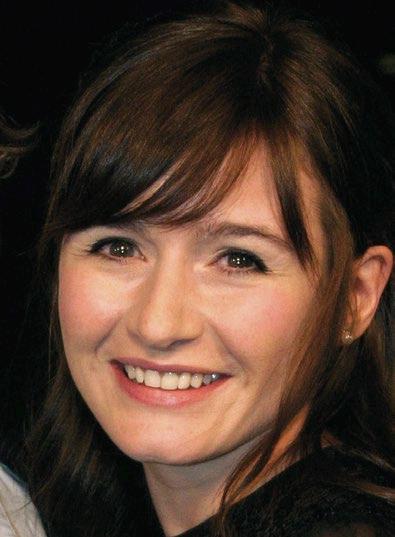
health, love, birth, death, divorce, sexuality—it all comes up in a way that’s really brave and outrageous. It’s awesome seeing these liberal, left-wing intellectuals behaving like children and being governed by their passions in a way that begs the question: who really knows anything?”
It’s a question the cast of The Party (which includes Timothy Spall, Patricia Clarkson and
Cillian Murphy) were forced to ask themselves when they arrived on set the morning after Brexit, bowled over by the result.
“Literally everybody went away from the set that night not thinking by any stretch of the imagination that we’d come back the next morning and no longer be in Europe,” she laughs, clearly still incredulous. “It was amazing to think that there we were making this film about Britain’s political climate and yet not one of us had imagined that the climate of the entire country was going to change overnight.
“What I love about this film is how you realise even people who have devoted their lives to informing themselves on the important matters of the day come at everything from an emotional point of view. We’re all driven by our passions, by our culture by our friends, by the articles we read on our f*****g Twitter accounts…”
One way in which Emily’s retaining a sense of her British identity is through her children, 13-yearold Sam and seven-year-old May. “I took them to my former university [Lincoln College, Oxford where she studied Russian] the other day hoping they’d fall in love. It’s such a beautiful cloistered college I thought it might look like Hogwarts. I try all sorts of stealths…”

10•2017 | 23
READER’S DIGEST
THIS TIME WITH HER CHILDREN IS PRECIOUS, and something she used to worry about missing out on as a busy working mother. Has that sense of guilt eased as they’ve grown older?
“Oh no, it only gets worse as they get older! I think they actually need you more,” she laments. “My 13-yearold needs me more than ever. The just-turning-into-teen years are such a vulnerable, sweet age of crossover from child to man. I think guilt is just an emotion you have to accept as a parent, no matter what job you do.
“You always just feel guilty and worried and like you didn’t do it right, or you haven’t done enough, but
about it too much because you don’t want to rub their noses in it, but with Doll & Em it was quite the opposite. Everyone was involved—my mum, my children, my husband produced and all our friends were involved from the costume design to the music. It was an amazing feeling having the people you love most in the world coming with you on this journey.
“One of our kids—I think it was Dolly’s son Ezzie—texted an old friend of Dolly’s saying something like, ‘Doll & Em is the dog’s b******s’ and for weeks this girl was labouring under the illusion that Dolly sent it.” She’s lost in a fit of giggles.
Guilt is just an emotion you have to accept as a parent, no matter what job you do
that’s OK. I certainly don’t think the answer is to not work. Nobody does well if they force themselves to stay at home. One just becomes miserable.”
Working closer to her loved ones was a happy side effect of Doll & Em, the hit TV show she co-wrote and starred in with real-life best friend, actress Dolly Wells. The comedy follows an actress named Em who hires her best friend Doll (no prizes for guessing who plays who) as her personal assistant.
“Normally when you do a job you’re far away from your family and in some ways you don’t want to talk
Though writing Doll & Em wasn’t her first experience on the other side of the camera—Emily has previously worked on a column for The Daily Telegraph and adapted Lorna Sage’s memoir Bad Blood—there was a unique release that came with a subject matter so close to home.
“I enjoyed the chance to be really honest. There’s sometimes quite a lonely and isolated feeling when you’re acting. You can get completely convinced that everybody hates you, and that you’re doing a terrible job. You look behind the monitor and see people whispering and feel sure
24 | 10•2017
“WHO REALLY KNOWS ANYTHING?”
© HBO / EVERETT COLLECTION INC/ALAMY STOCK PHOTO
they’re about to fire you. It’s a breeding ground for paranoia and there are moments when it can get terribly bad.
“It’s ridiculous where one’s brain goes when you put yourself in that vulnerable position where you’re longing for approval all the time. You never get it at home when you need it either; you only get it when you don’t. It was so cathartic to write about that feeling and make it funny.”
Emily is known for her daring and diverse choices, which range from the terrifying Shutter Island to the familyfriendly Pink Panther films. Despite her varied taste, are there any dream roles she hasn’t had chance to play?
“Yes,” she sighs, “but I’m too old for them now. I wish I could have been Katharine Hepburn. It’s so funny because I always thought of her as being such a grown-up and now I’m older than she was in any of the films that I love her in…though I guess I could be her in On Golden Pond!
“Really though, I just want to work with filmmakers that I love. I don’t
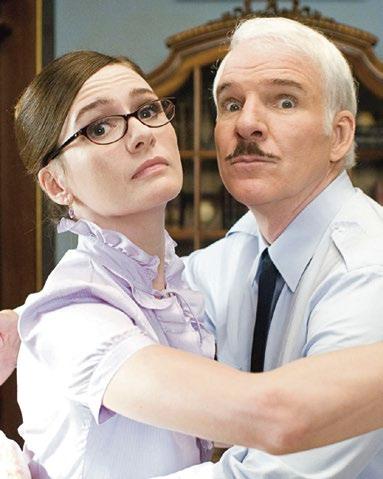
mind what part, though it would be cool to start playing more disastrous people…some really awful people.”
One upcoming project is pitched as far away from “awful” as possible. Emily is set to star as the grown-up Jane Banks in Disney’s Mary Poppins sequel—the imaginatively titled Mary Poppins Returns. Don’t expect her to launch into a rendition of “Supercalifragilisticexpialidocious” any time soon though. “I can’t sing for toffee. At school, they created a special class for my friend and me.

Emily first met best friend Dolly Wells when they were four years old; (above) starring alongside Steve Martin in the Pink Panther films
10•2017 | 25
“WHO REALLY KNOWS ANYTHING?”
We were so bad at singing that there were the ‘robins’ and the ‘larks’ and we were the ‘crows’. I’ve been selfconscious about my singing voice ever since.
“I did have to sing a tiny bit and Emily Blunt [who’ll be taking on Julie Andrews’s mantle as Mary Poppins] said she could see my entire body going into spasms as I waited for my one moment. It’s a pathological fear, like other people have of heights, but I overcame it and it worked out.”
ONE MIGHT THINK 20 YEARS IN THE INDUSTRY would dull the shine of filmmaking. Not so for Emily. Her fervour for her work remains that of a giddy teenage thespian.
“The feeling I’ve always loved the most—whether you’re performing, producing or writing—is people coming together with a desire to make something happen. It’s such a folly to the imagination trying to make a film or a TV show or a play. The chances of success are slim and yet people are so passionate about it.
“A cinematographer I worked with on Transsiberian has an expression for those who are foolhardy enough to think they can make a film. He calls them Perro Verde, which translates as ‘Green Dog’ in Spanish. It means a completely madcap individual who has the courage and crazy determination and…oh, I don’t know,” the words tumble as she talks, so eager is she to convey the joy that is filmmaking, “that sense of battling the odds or something, to really do this thing.”
“You go through life and you meet these Perro Verdes and think, This is cool, this is right. You just try to tell a story that means something.
“Very often you don’t manage it, and the story you’re telling doesn’t really mean anything to anybody. But sometimes, just sometimes…” She pauses, all that giddy love for her craft hanging in the silence. “You get it right.”
TIME IS MONEY
Bill Gates earns so much money per second that if he dropped a $100 bill, it wouldn’t make financial sense for him to spend the time bending down to pick it up.
| 10•2017
The Party is released in cinemas on October 13 and is reviewed on p18.
FOR MORE, GO TO READERSDIGEST.CO.UK/ENTERTAINMENT
26
SOURCE: THE SCALE OF THINGS BY MIKE FAIRBRASS AND DAVID TANGUY

DON’T GET COLD FEET
Imbue your favourite place to sit with warmth and comfort with a RugBuddy under-rug heater
Cold floors and air currents caused by wallmounted radiators leave many of us with chilly feet, but turning up the heating is not always the solution. Strong convection air currents from radiators are warm at ceiling level but turn into cold draughts at floor level, leaving your upper half warm and your toes icy.
If this problem sounds familiar, you will be relieved to discover the new Be Warmer “RugBuddy” heater, which tackles this problem feet first! The heater typically costs five pence per hour to run (varies with size) and provides warmth where you need it, under your feet.
Simply lay out the RugBuddy at the foot of your seat, cover with a rug, and plug it

Additional info
✚ Use on top of tiles, wood, laminate and carpet
✚ Wide range of sizes
✚ 'CE Marked'/ 'IEC Approved' quality


✚ 30-day “No Quibble” guarantee
✚ 2 years manufacturer’s guarantee
in. Within 20 minutes you will be enjoying a warm floor that radiates heat gently upwards and keeps you snug.
You may even find, with a RugBuddy keeping you cosy, that you save money on central heating. The independent Energy Saving Trust calculates you save £80 per year for every degree you turn down the central heating.
FURTHER INFORMATION
Head to BeWarmer.co.uk to get your very own RugBuddy and redeem an exclusive Reader’s Digest o er: Use code RDSEP17 for a FREE safety plug adaptor when you order a RugBuddy bundle (recommended) this September.
Right Rug Buddy by Be
Warmer

SPONSORED CONTENT
The Reverend Richard Coles, 55, first found fame in pop band The Communards. He’s now a Church of England priest, and is appearing in this year’s Strictly Come Dancing
“I Remember” Richard Coles The Reverend
… THE MIDWIFE SAID IT WAS A GOOD OMEN. I was born in the village of Barton Seagrave near Kettering, Northamptonshire on March 26, 1962.
My grandfather and father both worked in shoe manufacturing and, apparently, as I appeared, the midwife exclaimed, “Ooh, Mrs Coles, he’s got clicker’s hands.”
Clicking—cutting out shapes from a hide to make up a shoe—was the best-paid job in a shoe factory.
.…I’VE LOVED MUSIC EVER SINCE I CAN REMEMBER. I started playing the piano when I was only four in an effort to copy my funny, flamboyant grandfather Eric Keith Coles who used to sing “Sam Sam Pick Oop Tha’ Musket” while playing his baby grand.
When I was eight, my father took me to see a performance of Beethoven’s Seventh Symphony at the Albert Hall and I was so affected by it that I kept trying to stand on my chair and conduct.
28
WENN LTD/ALAMY STOCK PHOTO ENTERTAINMENT
 The Reverend Richard Coles attends the Cheltenham Literature Festival in 2015
The Reverend Richard Coles attends the Cheltenham Literature Festival in 2015
…I GOT LUCKY WITH MY PARENTS, ELIZABETH AND NIGEL.
I have happy memories of climbing into bed with Mum and Dad on a Sunday morning and Dad telling such good stories—ones he’d made up involving a Russian spy called Ram Doddler and another character called Evil Stravinsky. He was a very sweet, kind father and the gentlest and most gentlemanly of men.

Both my parents were unfailingly loving and supportive. I remember seeing my mother as a rather glamorous figure. She and my father had busy social lives—playing badminton, attending concerts and going to the local ski club.
…BEING SOMEWHAT
PRECOCIOUS. I had moments of insight when I was still very tiny. Running around the garden one day, I stopped dead in my tracks when the thought occurred to me that things were not necessarily as they seemed. Aged five, I suspected there was no such thing as Father Christmas and stayed awake all night to find out. Of course I pretended to be asleep when Dad crept in with my stocking.
My older and younger brothers, Andy and Will, loved to play cowboys
and Indians but I read constantly. At six, it was discovered that I had a reading age of 12.
…FEELING AT PEACE IN THE SCHOOL CHAPEL. As a family, we only went to church at Easter and Christmas but, at the local public school, we had chapel every morning. That’s where I acquired my love of Anglican choral music and discovered that I had quite a good voice. With my competitive nature, I clawed my way to become head chorister. When I started playing the organ, I found the atmosphere of the chapel gave me such a release from anxiety, and a sense of peace.
Richard was a voracious reader from an early age; (above left) with his mother, Elizabeth, and Jimmy Somerville

30 | 10•2017
I REMEMBER
I loathed football and asked to do knitting with the girls—and I wept bitterly when a boy knocked over my snowman at school
...NOT FITTING IN. I loathed football and asked to do knitting with the girls—and I wept bitterly when a boy knocked over my snowman at junior school. I think I knew I was different from the age of about eight.
Growing up gay in 1970s Britain, there was a time when I wished I could become heterosexual. To be labelled a “poof” then was the greatest taboo. Teenagehood simultaneously produced a desperate desire for sex and a desperate fear of being thought “queer”.
I started to feel physically unattractive and can still be stopped in my tracks remembering what happened at a ceilidh in Kettering. When the music stopped, boys had to peck the cheek of the girls. But when I bent forward, the girl opposite me physically recoiled and said, “Eeurgh!”
...TOM ROBINSON HELPED ME COME OUT. After leaving school with four O-levels, I went to drama school in Stratford-upon-Avon. The liberal, bohemian atmosphere gave
me the opportunity to come out. I played my mother Tom Robinson’s “(Sing If You’re) Glad to Be Gay” two or three times and she said, “Darling, are you trying to tell me something?”
…MEETING JIMMY SOMERVILLE. I first met Jimmy in a gay bookshop in London. His Scottish accent was so strong, I only got a fraction of what he said and he was only a little over five feet. But he dazzled me with his toughness, sexual confidence, style and his interest in me. Perhaps it was the attraction of opposites.
A group of us were making a film about young, gay Londoners and we needed music. When Jimmy opened his mouth and sang, he produced a voice like an angel—simultaneously fragile and strong. The room fell silent and a star was born. I was both gratified and envious when he formed Bronski Beat and their debut single, “Smalltown Boy”, reached number three in the charts.
…MY FIRST TASTE OF BEING A POP
STAR. When Jimmy asked me to play saxophone for Bronski Beat, I practised and practised—under the duvet, so I wouldn’t drive the upstairs neighbours mad.
I absolutely loved being up on stage with them and thought to myself, Life is going to be different from now on! I bought myself a Fifties-style grey suit from a charity shop to wear on my first trip abroad
31 10•2017 |
READER’S DIGEST
with the band. Geneva airport looked like Madam Tussaud’s—there were famous people everywhere.
… BEING IN THE MONEY.
After Jimmy left Bronski Beat, he and I formed The Communards. I was paid an advance of £60,000—a dazzling sum I could hardly imagine—and bought myself a lovely grand piano. I remember that when I paid a royalty cheque into my local bank, the counter clerk barely looked up. His jaw dropped when he saw the six-figure sum! I only have vague memories of buying a speedboat on a wild holiday to Ibiza because I was off my head on drugs.
…MEETING PAUL
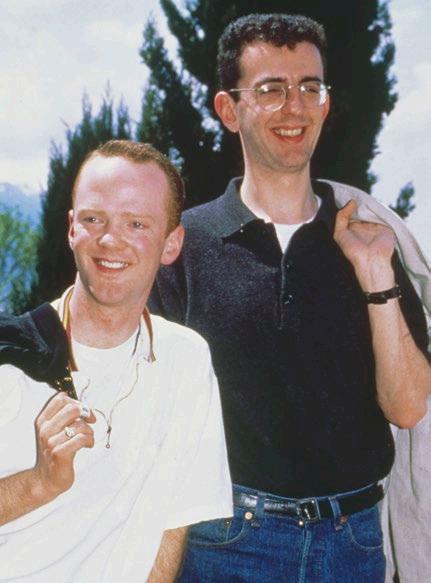

WELLER. Jimmy and I got involved with Red Wedge, a collective of musicians wanting to switch young people on to politics. Paul Weller was by far the coolest person I had ever met. Performing “Moving On Up” was the happiest five minutes I’ve ever spent on stage.
….THE BEST OF TIMES, THE WORST OF TIMES.
Our success coincided with the first years of the HIV epidemic. We were waiting to go
Finding success with Jimmy; (left) with Paul Weller
on stage for the Spanish Top of the Pops when a phone call brought the news that our dear friend Mark Ashton had died of AIDS. Everyone was crying and the poor woman from the record company said, “I’m sorry, you’re on,” and we had to walk into a wall of children’s screams and mime our way through “Don’t Leave Me This Way.” The song went on to be the biggest-selling record in 1986.
As friend after friend died of AIDS, I could not believe in a universe that
32 | 10•2017 I REMEMBER
PICTORIAL PRESS LTD/ALAMY STOCK PHOTO
I felt the strongest pang of homesickness—not just for home, but for a life than made more sense to me
made any kind of sense. Some months later, on tour and alone in my hotel room, I felt the strongest pang of homesickness. Not just for home, but for a life that made more sense to me.
….YEARNING FOR PEACE AND SENSE.
I started to feel twinges towards religion after I witnessed the extraordinarily devoted care from Christians working in hospices, nursing people with AIDS.
Coming back from the Edinburgh Festival, I got off the train early and found myself heading to York Minster where I looked at the Seven Sisters window and tried to decode what the building was telling me. In the shop, I intended to buy a postcard, but bought a silver cross on a chain. It was such a significant moment, for I went in a tourist but came out a participant.
…BECOMING A STUDENT AGAIN.
When I told an old friend I was off to take a theology degree at King’s College, London, he replied,
“Geology?” It took me three goes before he got it.
I discovered how much I loved the communal life based around the chapel, singing in the choir and learning. When I started reading the gospels in the first-century Greek they were written in, they came alive, like rivers flowing through a wilderness.
…THE DAY I WAS ORDAINED.
After four years’ training, I was ordained to the priesthood at St Botolph’s in Boston, Lincolnshire in 2006 in front of parishioners, colleagues, my family and friends. The beginning of the service was a blur of faces and a wash of sound.
Afterwards, I greeted, it seemed, almost everyone I’d ever known. I remember looking into people’s faces—faces that had seen me at my best and my worst, at my most vulnerable and my most triumphant, my sleaziest and my finest. I think there was always a vicar in me, struggling to get out.
…MEETING MY PARTNER, DAVID.
I entered the priesthood thinking I would be on my own, but one day I was preaching a sermon in Boston when I caught site of a handsome young man in the congregation, looking at me with something more than curiosity.
Afterwards, he introduced himself as David, a member of the Parochial Church Council. On impulse I asked
33 10•2017 | READER’S DIGEST
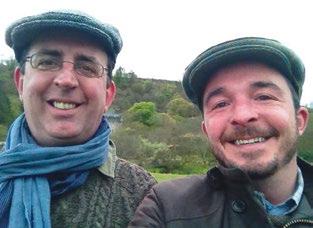
if he had a fag and we stood outside, me in a cassock, smoking on a roastingly hot day. When he came round for lunch a week later, we talked all afternoon. David and I just fit together.
…THE FIRST TIME I VISITED THE KINTYRE PENINSULA. When we went on holiday to the Kintyre peninsula in western Scotland, I loved it from the moment we arrived.
It’s about as remote as you can get on mainland Britain and so beautiful it’s well worth the epic journey. From our rented cabin, at the edge of a shingle beach, I sat and watched sea otters beyond the rocks. Now we go back every year with our menagerie of dachshunds.
It’s a place where I can return to regular periods of silent prayer. In front of the cabin is a life-sized Anthony Gormley figure, lapped by the tides. It is, for me, an image of the priest—feet on the ground but looking out to the far horizon. As told to Amanda Riley-Jones
Bringing in the Sheaves: Wheat and Chaff from My Years as a Priest by The Reverend Richard Coles is published this month by Weidenfeld & Nicolson at £8.99.
ECCLESIASTICAL BANTER

The church signs in the US are certainly attention-grabbing:


SOURCE: BOREDPANDA.COM

| 10•2017 34 I REMEMBER
With his partner, David, in Scotland
FOR MORE, GO TO READERSDIGEST.CO.UK/ENTERTAINMENT




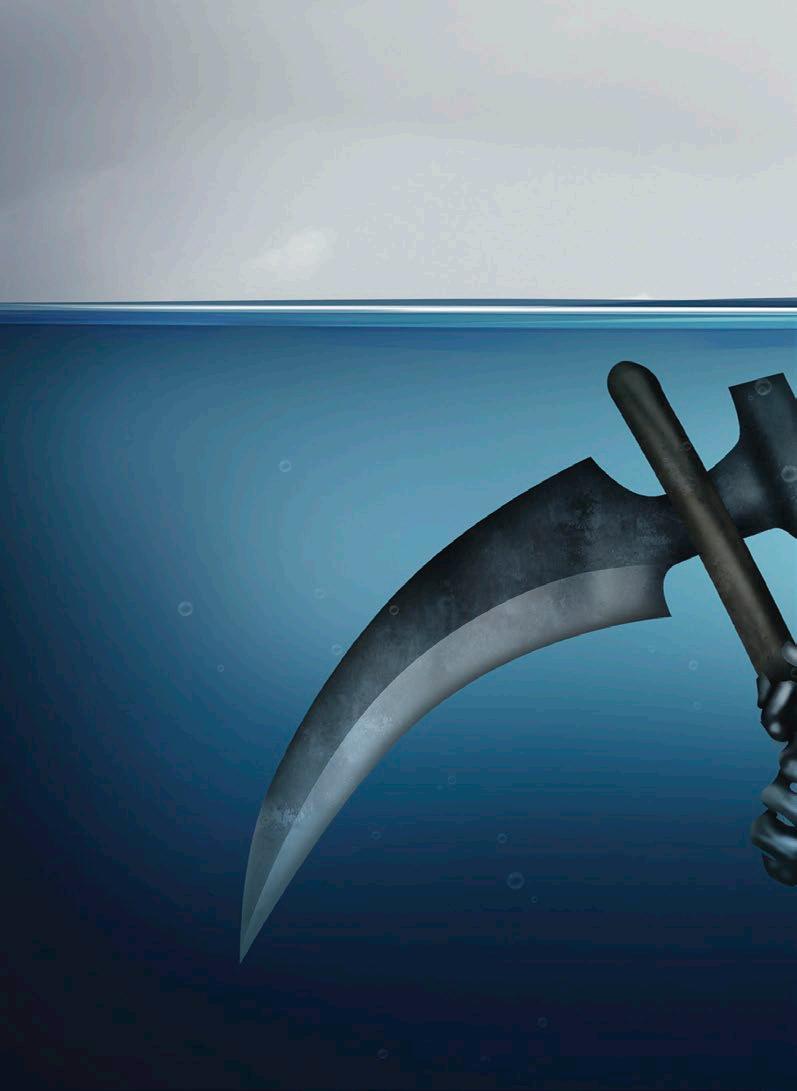
Who Live Wants to
Forever?
As a species, we humans appear to be the undisputed masters of our planet. Moreover, since Yuri Gagarin’s inaugural space flight in 1961, we can even leave the confines of Earth to travel in space. Yet, we have one Achilles’ heel—we’re mortal
BY CHRIS MENON
HEALTH 36

BRAIN LIGHT/ALAMY STOCK PHOTO
AT 122 YEARS, THE MAXIMUM HUMAN LIFESPAN lags
well behind some species of giant tortoise (188 years), Greenland shark (400 years) and the record set by the lowly Icelandic clam (507 years). Even those relatively few humans who do manage to make it past 100—some 14,570 people in the UK in 2015—are invariably bedeviled by poor health.
Recently, efforts to extend the healthy human lifespan have achieved much publicity following the backing of visionary, super-rich Silicon Valley tech entrepreneurs. In 2013, Google’s founders created a subsidiary company called Calico (short for the California Life Company), which promptly hired a team of top scientists and now has more than £1bn in the bank to fund its work. Its CEO, Arthur Levinson (who’s also chairman of Apple), has stated, “Our goal is to make progress on a very basic challenge—how to help people stay healthier for longer.”
Calico have ignored our requests for more information about this research. Yet in March it partnered with C4 Therapeutics to use the latter’s technology platform to develop small-molecule drugs. These drugs are designed to direct a specific mechanism in our cells, enabling them to selectively degrade diseasecausing proteins—thus lessening incidences of Alzheimer’s, cancer and inflammatory conditions such as rheumatoid arthritis.
Jeff Bezos, the billionaire founder
of Amazon, has similarly invested in Unity Biotechnology, which aims “to design therapeutics that prevent, halt, or reverse diseases of ageing”. Unity intends to develop a new class of therapies called “senolytic medicines”, designed to selectively eliminate senescent cells. Senescent cells accumulate with age and, unlike normal cells, they secrete inflammatory molecules that harm neighbouring cells and tissues, causing osteoarthritis, glaucoma, and atherosclerosis.
Not to be outdone by his fellow Silicon Valley billionaires, Elon Musk, co-founder of Paypal and the mastermind behind Tesla, has launched the medical research company, Neuralink. It intends to eventually enhance human brains by connecting them with computers so that thoughts—maybe even human consciousness—can be uploaded and downloaded. This might eventually provide humans with a form of virtual immortality.
However, even among scientists, opinions differ greatly as to what is feasible and the likely timescales.
ZUMA PRESS, INC./DPA PICTURE ALLIANCE /BOB DAEMMRICH/ALAMY STOCK PHOTO | 10•2017
WHO WANTS TO LIVE FOREVER? 38


Ultra-rich researchers
Some believe that death, like any disease, can be cured, while others seek to develop drugs that will provide an incremental increase in healthy lifespans.
Arthur Levinson, Jeff
Bezos and Elon Musk

IN THE US, THE SENS RESEARCH FOUNDATION aims to discover ways to fix or undo the damage the body automatically does to itself over time. For example, it’s currently addressing age-related hypertension by developing enzymes that can break the accumulating chemical bonds that make our major arteries stiffer, as well as identifying ways to kill particularly dangerous cancers.
Its chief science officer, Aubrey de Grey, is optimistic about the prospects for curing ageing. “I think the damage-repair rejuvenation
technologies that the SENS Research Foundation is pursuing have a good chance of becoming comprehensive enough to merit being described as a solution to ageing within about 20 years. However, I need to stress that that depends on financial support.”
Considered by many as an “immortalist”, when asked if life beyond 1,000 is a possibility, de Grey contends, “There’s honestly no limit. If anything, 1,000 years is conservative. The point is that the body’s a machine—periodic preventative maintenance, once we’ve developed the tools, will be just as effective in maintaining it indefinitely at full performance as we can already do for a vintage car or aeroplane.”
Dr. João Pedro de Magalhães,
10•2017 | 39
associate professor in ageing at Liverpool University, accepts the theoretical possibility that ageing can be cured. “Ageing is surprisingly plastic in the sense that it can be manipulated by genes, evolution and diet.” Although he believes those tools are still a long time away.
“At the current rate of progress radical life extension will take centuries,” he admits.
Yet, de Magalhães does believe incremental increases are more likely. “In species such as mice, drugs have been shown to have five to 20 per cent longevity benefits—although these will likely be lower in humans. Yet retarding human ageing, even by a small degree, would still have a big impact on human health and life—I’m convinced that longevity drugs will become widespread in the next 20 years.” For example, a drug might be taken daily for life as a preventative measure to ward off the possibility of developing cancer.
Research at the Albert Einstein College of Medicine in New York, who strives to improve healthspan, not lifespan. “My goal is to delay ageing, to make 80 the new 60— not to live to be 800. Aubrey wants to be something more dramatic, he wants to never die.

Even if you can replace cells in the brain with new cells, your memory is going to go. So who are you in this new body?
Aubrey de Grey is an immortalist.”
Next year, Barzlai, who discovered longevity genes in centenarians, is to launch the first trial of an anti-ageing drug with the approval of the US Food and Drug Administration. The medicine in question is an old drug for type-2 diabetes called metformin, which acts on the mitochondria, the cellular power plants. Metformin has been shown to affect the receptors for particular biochemical pathways that are associated with longevity.
Another scientist even more sceptical of Aubrey de Grey’s grandiose visions is Dr Nir Barzilai, director of the Institute for Ageing
“I think that maximal lifespan is about 115 [based on global lifespan data trends] which means we have a lot of potential as the average age of death in the western world is currently around 80. Please note that I’m concerned with how we expand the healthspan of our population.
| 10•2017
WHO WANTS TO LIVE FOREVER? 40
Lifespan is simply a side effect,” enthuses Barzlai.
He adds, “That doesn’t mean that in the future we cannot extend life, or even start thinking about it sooner. But this is a little bit different technologically— and even if you can replace cells and the brain with new cells, well, your memory is going to go. So who are you in this new body? There are lots of ethical and biological issues.”

In such a scenario one has to wonder what would happen to our fundamental sense of self. Would it undergo a transformation as profound as the physical one? There are many unknowns.
ENVIRONMENTAL FACTORS ARE ALSO IMPORTANT for longevity, as Howard Friedman, distinguished professor in the psychology department at the University of California, explains. “Genes account for about a quarter of the variation in longevity [in a given population]. The rest is environmental/behavioural factors and chance.”
Indeed, our lifestyle choices affect ageing and there’s ample medical
SENS Research Foundation chief science officer, Aubrey de Grey, addresses the 2015 Open Innovations Forum and Technology Show at the VDNKh Exhibition Centre
evidence to suggest that smoking, drinking and a sedentary lifestyle can shorten your life. For example, according to Cancer Research UK, smoking causes 28 per cent of cancer deaths in the UK.
Rather than focusing on radically improving lifespan, Friedman’s focus is on how to stop so many people from becoming ill in their 50s, 60s and early 70s—and to help most people thrive into their 80s and even 90s. A shift in attitude is required in order to create a world in which more effort is spent to encourage people to take preventative measures and assume more responsibility for their health, instead of being passive recipients of medical procedures.
According to Friedman, “Taking it
ITAR-TASS PHOTO AGENCY/ALAMY STOCK PHOTO 10•2017 |
41
HOW TO LIVE LONGER
Professor Howard Friedman is author of The Longevity Project, which studied 1,500 Californian children from 1921 for 90 years. He shares seven tips for a long, healthy life:
1. Develop good social ties with a healthy community.
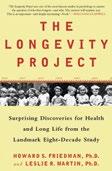
2. Stay physically active. Do anything that gets you out of your chair! Walk, cycle, cook, garden, swim, dance, play a musical instrument…anything that will keep you up and about for several hours a day.
3. Forget tobacco and drugs. Smoking and drug abuse remain the most important preventable behavioural causes of illness and ordinary death.
4. Be responsibly prudent. Consider the things your mother, teachers, doctors and nurses advised—from wearing seat belts to protecting against sexually transmitted diseases. The small things add up to big pay-offs over time.
5. Avoid obesity. Eat proper amounts of nutritious food, including vegetables, nuts, fruits, beans, and healthy fats found in avocado and olive oil.
6. Have a best friend. Or two.
7. Choose something worthwhile or meaningful to do in your life. Volunteer to help those less fortunate, assist a local club in cleaning up parks, or take up a hobby such as gardening or guitar—and become an expert in it.
easy is not usually a path to good health or a long life.
“Well over half of the variation in longevity is due to how you live. That is, genes do matter but not as much as most people assume.”
PROFESSOR JOHN
NAUGHTON, a senior research fellow at Cambridge University, acknowledges that a lot of serious research is going into eradicating diseases and increasing health into old age. Nevertheless, he argues that those Silicon Valley tech titans who believe our genetic code, like software, can be “cracked” to radically extend lifespan are deluded by their own hubris. “These people have parted company with reality,” he says.
While increasing healthspan could have positive societal ramifications, radically reducing the costs of looking after the elderly, there would likely be less favourable consequences from any increased lifespan enabled by costly drugs. Naughton warns, “Lifespan would become a matter of wealth to an even greater extent than it already is. WHO statistics
| 10•2017
TO LIVE FOREVER? 42
WHO WANTS
put male life expectancy in the Calton district of Glasgow at 54. Eight miles away in the affluent Lenzie, the corresponding figure is 82. And the reason for the discrepancy? Poverty.”
One dystopian future ushered in by medical science might be one in which power and wealth have been concentrated in the hands of a superaged minority, a ruling caste that can pop pills to extend their lives while the rest of humanity age painfully. In such circumstances, wouldn’t the vitality of youth and innovation be hampered by an elite whose collective mindset was formed in the century before?

Lifespan would become a matter of wealth to an even greater extent than it already is
Yet, perhaps this is too pessimistic a picture to paint and we should welcome the fact that increasing life expectancy could improve the
collective wisdom of humanity. Dr George Leeson, director of the Oxford Institute of Population Ageing, explains, “Life expectancy today is 80 years. Let’s say it goes up to 110 over the next 100 years—that’s a 30-year increase, which isn’t unlikely. That’s exactly the sort of increase we’ve had over the past 100 years. That past 100 years has been a century of unprecedented growth and increase in our standards of living and welfare. What’s making us think it’s all going to fall apart just because we’re going to be living an extra 30 years?
Where has our faith in human ingenuity and invention gone?
“I’ve always said as a demographer, if you get worried looking into the future, take comfort by looking into the past.”
NO NEWS IS GOOD NEWS
On April 18, 1930 the BBC’s newsreader had something a little different to announce. “There is no news”, read the simple script of the bulletin before piano music was played for the remainder of the 15-minute segment. How different April 18, 2017 proved to be, as Prime Minister Theresa May announced her plan to call an early general election.
SOURCE: BBC.CO.UK
10•2017 |
READER’S DIGEST 43
The Healing Power Of Cats
BY SUSANNAH HICKLING

Susannah is twice winner of the Guild of Health Writers
Best Consumer Magazine Health Feature

WOO-OOO, IT’S HALLOWEEN and there’s no avoiding the pictures of black cats everywhere. But throw superstition out the window—it’s scientifically proven that cats are the purr-fect pet for your health.
YOUR CAT CAN CUT YOUR RISK OF HEART DISEASE.
According to an American study, feline friends lower stress levels and blood pressure, and you’re less likely to die of a heart attack or stroke. The effect even extended to people who’d owned pussycats in the past.
PURRING HELPS HEAL MUSCLES, BONES AND TENDONS. Yes, really! Research suggests that the sound your contented cat makes has a therapeutic effect. It’s all to do with the frequency, apparently. Pussies’ purring falls within a frequency range that researchers have found to improve bone density and promote healing.
SAY “HELLO KITTY” FOR HEALTHIER CHILDREN. There’s evidence that cats can help children with autism communicate better and be more assertive, and that babies have fewer respiratory and other infections when there’s a moggy around.

| 10•2017 44 HEALTH
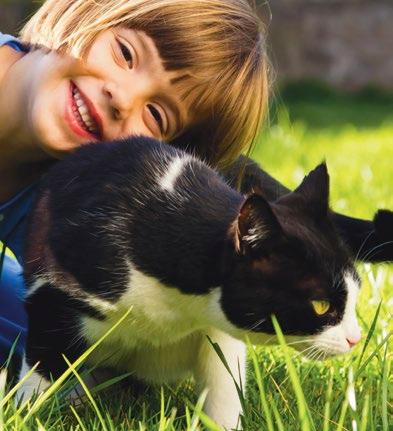
Children are also less likely to develop allergies.
GET A SHOT OF FELINE FEELGOOD FACTOR. A Cats Protection survey found that 87 per cent of cat owners believed their pet had a positive effect on their sense of wellbeing and 76 per cent said that it helped them cope with everyday life. Half of moggy masters and mistresses enjoyed the companionship, while a third found stroking their cat to be a calming activity.
DON’T OWN A CAT OR ARE ALLERGIC TO THEM? Don’t despair. A survey from the University of Indiana, in the US, found that people who watch cat videos—a popular online occupation—had more energy and were more positive afterwards, and felt fewer negative emotions, such as anxiety or irritation.
BACK TO THE FUTURE
Bone density loss is a fact of life for many older people, especially women, but the good news is you can take action to improve density and help prevent spinal fractures before it’s too late. Here’s how:
EAT WELL. You should aim for a healthy, balanced diet with plenty of calcium—think dairy products, broccoli, sardines and nuts.
MAKE EVERY DAY D-DAY. As well as eating foods that are rich in vitamin D, such as eggs and oily fish, you might need to take a vitamin D supplement. Speak to your GP.
DRINK WATER. to eight glasses of water a day. Staying hydrated will make you less stiff and help keep your spine healthy.
GET PHYSICAL. best bone loss prevention measures is exercise. But take note; you need to do strength training to build muscles as well as moderate aerobic exercise three times a week.
LEARN GOOD POSTURE. Imagine there’s a string attached to the top of your head pulling you gently upwards. This will keep your bones aligned and avoid unnecessary stress on your body.

10•2017 | 45 READER’S DIGEST © SHUTTERSTOCK
What’s Causing Your Nightmares?
SNACKING AT NIGHT. While the old myth about chomping cheese at night causing bad dreams doesn’t have a whole lot of evidence to support it, having a snack before you turn in for the night can make your brain more active.

DEPRESSION AND STRESS. These conditions act as psychological triggers for nightmares.
DEPRESSION PILLS. But, perhaps unexpectedly, anti-depressants can also give you unpleasant dreams. A recent review of research found they actually doubled the risk of mood problems, including nightmares.
SLEEP DEPRIVATION. Yes, that’s right, interrupted sleep can bring on bad dreams which, in turn, cause you to lose more sleep.
SLEEP APNOEA. Unsurprising, really, that you may have scary dreams if you continually stop breathing while asleep. It is, however, surprisingly common.
RESTLESS LEGS. Again, this sleep disorder which causes involuntary leg movements, even crawling sensations, is likely to disrupt your night-time tranquillity. But, like many of the other causes of nightmares, you can take action to alleviate the problem. Your GP should be able to advise on many of these issues.
SLEEP EASY
With the clocks going back and giving you an extra hour, now’s the time to press the sleep reset button. How? The Sleep Council has come up with the 30day better sleep plan, a downloadable tailored programme to kickstart a better rest routine. You can find it at sleepcouncil.org.uk/30-day-plan
HEALTH | 10•2017 46
© SHUTTERSTOCK
Should you take a multivitamin?
Skip it if…you eat a balanced diet, which is, after all, what you should be aiming to do!
Pop it if…you often skip meals or eat on the go. But, remember, multivitamins are not there to replace meals, but to back them up. Stress, dieting, getting older and some medications may also mean you need a nutritional boost.

6 Ways To... Sort Your Psoriasis
Recent research from Sweden has shown that this autoimmune skin condition is more common in men. What’s more, it’s been linked to erectile dysfunction. To prevent flare-ups:
1. Moisturise. Having dry skin makes psoriasis worse, so use creams and lotions.
2. Avoid cold, dry weather. Easier said than done with summer well and truly behind us; consider booking a winter sun holiday.
3. Don’t get a tattoo. Cuts, scrapes and skin infections can cause problems for people with psoriasis. Be careful when shaving too.
4. Check your meds. Some drugs used to treat other conditions can cause a psoriasis flare-up, such as beta blockers, prescribed for heart conditions. Talk to your GP.
5. Stress less. Think about how to tackle worry and anxiety, which are psoriasis triggers for some people. Try yoga, for example, or take up a sport.
6. Lose those extra kilos. Being overweight can also give some psoriasis sufferers more grief, so eat a healthy diet containing more fruit and veg, cut back on those empty calories in booze and exercise regularly.
MEN’S HEALTH © SHUTTERSTOCK
MULTI CHOICE...
10•2017 | 47 READER’S DIGEST
Full Of Beans
BY FIONA HICKS

Fiona studies
Naturopathic Nutrition at the College of Naturopathic Medicine, and is a member of the Nutrition Society
RESEARCH SUGGESTS THAT UPPING YOUR INTAKE OF LEGUMES AND PULSES can lower your risk of heart disease, reduce over-eating and increase energy—among many other health benefits. Here are our top picks, plus tips on how to enjoy them.
BLACK BEANS. Consumption of black beans is associated with lower colon cancer incidence—possibly because they’re especially good at feeding the friendly bacteria that keep our colons healthy. Why not try black bean soup for a warming mid-week meal? Simply combine the beans with some vegetables and stock and heat through.
NUTRITION NEWS
New research suggests that a diet rich in tomatoes could reduce the risk of skin cancer. The study, conducted at The Ohio State University, found that male mice who were fed a diet of ten per cent tomato powder experienced a 50 per cent reduction in skin cancer when exposed to UV light, compared to non-tomato-eating mice. It’s thought that the carotenoids (pigments) in tomatoes protect the skin against UV damage.

| 10•2017 48 HEALTH
THE NUTRITION CONNECTION

CHICKPEAS. This humble legume contains a good ratio of protein and carbohydrate, plus a little fat, which helps keep you satiated. In fact, a study found that people who had chickpeas in their diet ate less overall, helping to keep body weight lower. Blend chickpeas with olive oil, lemon, garlic and tahini for an easy hummus dip.
LENTILS. These are rich in both soluble and insoluble fibre, which not only help to keep you regular, but can also lower cholesterol. Lentils soak up flavours easily, so are perfect for adding to casseroles and stews.
KIDNEY BEANS. These starchy beans provide a steady, slow-release source of energy while keeping your blood
sugar stable. This means they could be particularly beneficial to type-2 diabetics, or those who regularly experience energy crashes. What’s more, they’re also a good source of the essential mineral iron. Try swapping beef for kidney beans to make a tasty vegetarian chilli.
BUTTER BEANS. The largest of the legumes on our list—which are renowned for their smooth, buttery texture—are not only a good source of protein, but also manganese. This trace mineral is an important factor of antioxidant defence, helping you to ward off everything from colds to wrinkles. Cook butter beans with butternut squash, coconut milk and spices for a delicious curry.
10•2017 | 49 READER’S DIGEST © SHUTTERSTOCK
More Than Medicine
BY MAX PEMBERTON

Max is a hospital doctor, author and newspaper columnist
MEDICINE IS SUPPOSED TO BE UPBEAT; its aim is to save, improve, extend life. It’s this that the medical school curriculum focuses on and it’s because of this that I became a doctor. I’ve been taught about the weirdest and most obscure medical conditions that affect only a handful of people—but death, that most universal of problems? Not a thing.
In fact, when I first graduated and became a doctor, I wasn’t even sure how to tell if someone actually was dead. Dying people often look like dead people, making the exact moment when death occurs rather tricky to locate. Rather than “pronounce” people dead, which to me sounds rather official, I preferred to “suggest” that people had died, then leave for a bit and come back. If rigor mortis had set in, then I felt a bit more confident in my diagnosis—and this also gave me the added safety net that another doctor might have taken it upon themselves to pronounce them dead before I returned.
BECAUSE WE NEVER ACTUALLY THINK ABOUT medicine not working, about people dying, it comes as a bit of a shock when we’re faced with it. It’s hard because we’re never taught what to say and what not to say. But as a junior doctor, there was no escaping it—so when the nurse paged me to ask me to see Mrs Bullen, I had to go.
Mrs Bullen is dying. She’s had cancer on and off for ten years, and now it’s spread to all over her body. She has no family, although some neighbours visited this morning.
| 10•2017 50 HEALTH

She’s been getting worse over the past few hours. There’s nothing more I can do, and I’m perplexed as to why the nurse has called me.
“She wants to see you,” explains the nurse. “I think she knows it’s the end and she wants you to be there.”
“Can’t we get a priest or something?” I plead.
“Just pop your head in, Max,” suggests the nurse.
The curtains are drawn and there’s the peculiar musky smell that the nurses told me was a sign that someone is dying. I stand for a few moments, reluctant to go closer, when Mrs Bullen opens her eyes. “Thank you for all you’ve done, Doctor, and for being so kind to me,” she whispers through her oxygen mask. But I don’t feel I’ve done anything for her.
I ask her if there’s anything she wants, anything I can do—but she shakes her head and moves her hand towards mine, so I sit for what feels like a lifetime and hold her hand until I realise that she’s not breathing any more. I stay with her for a few more minutes and, while I sit there, it occurs to me that being a doctor is more than just doing exciting lifesaving procedures. What mattered more to Mrs Bullen—more than all the medicines and operations and tests—was that someone was by her side when she died.
I QUIETLY CLOSE THE DOOR behind me and go back onto the ward. Thankfully, when I return, another doctor has already pronounced Mrs Bullen dead.
BRAIN LIGHT/ALAMY STOCK PHOTO 10•2017 | 51
MEDICAL CONDITIONS—EXPLAINED
Irritable Bowel Syndrome
WHAT IS IT?
Irritable Bowel Syndrome (IBS) is a term used to describe a set of unpleasant and debilitating symptoms that affect the bowels. It’s incredibly common, with between ten and 20 per cent of the population having it at any one time. The symptoms include stomach cramps, bloating, diarrhoea and constipation. Stress may play a part, as people often find that it flares up when they are worried, nervous or anxious.
WHAT CAUSES IT?
While there’s no clear cause for the condition, it can follow an attack of gastroenteritis, a course of antibiotics or very upsetting or traumatic events. This seems to disrupt the normal functioning of the gut—stimulating the immune system, causing inflammation and disturbing the balance of bacteria in the gut. This leads to the gut becoming very sensitive.
HOW’S IT TREATED?
IBS is often a lifelong condition and requires constant management of symptoms. People often find that

changing their diet can help. Keeping a food diary and monitoring what you eat and when flare-ups occur can help identify food to avoid. There’s also a particular approach called the FODMAP diet, which involves avoiding foods with certain types of carbohydrates. This needs to be done under the guidance of a dietician.
WHAT CAN THE PATIENT DO?
Eating regularly helps, as can reducing alcohol and caffeine. If you have wind or bloating, eating whole oats or linseed can also help. There’s very good evidence to suggest that the probiotics Symprove and VSL#3 can reduce symptoms.
ILLUSTRATION
| 10•2017 52 HEALTH
BY DAVID HUMPHRIES

with vitamins A, B2 & Zinc which help to maintain normal vision
Visionace® is based on extensive research and has been expertly formulated with over 20 nutrients including Bilberry and Lutein, with specific nutrients to help support your vision.











From , Superdrug, Holland & Barrett, supermarkets, chemists, health stores www.visionace.com † A beneficial effect is obtained with a daily intake of 250mg of DHA.
GB ScanTrack Total Coverage Unit Sales 52 w/e 17 June 2017. 2017-08-22 ADVISCONP E ORIGINAL PLUS OMEGA-3 MAX Britain’s No.1 Vitamin Company*
*Nielsen
Seeing is believing...
Meet the family who prove that a diagnosis of autism doesn’t have to spell disaster
A Tale of Three Magical Children
BY PETER WOOLRICH
GIVEN THE CHANCE, 15-year-old Lenny King likes nothing more than to scale half a dozen sevenfoot-high garden fences and run across the busy road to the Co-op, which he associates with free biscuits. His sister Daisy, 17, frequently falls over, which is good because she was told she’d never walk. The eldest, 19-year-old Rosie, might launch into an outburst of swearing at any moment or, jealous of her siblings, simply tell people she’s constipated.
The King family are special in a number of ways. Not only are all three children on the autism spectrum, but their parents—rather than see their situation as at best unlucky and at worst a curse—regard it as a blessing. “In some ways my children are forever young, still learning to say a few extra words or take a few extra steps, so while in most families the children grow-up and pull away from their parents, mine continue to be a source of childlike surprises. They keep on
54 © SHUTTERSTOCK
INSPIRE


providing us with those special moments that all parents cherish,” says mum Sharon, 47.
It should be said that Rosie no longer makes up stories about her bodily functions, which she did to get attention when people noticed her siblings’ more obvious physical characteristics and not her own. She’s now collaborated with her mother to write and illustrate a children’s book. The Diary of Arabella Crumblestone is a fairy tale about both autistic and non-autistic characters, two of whom aren’t entirely dissimilar to her brother and sister.
A few years ago Rosie received a standing ovation from a 1,000-strong TED Talk audience in America, which was screened live to 150 countries. She’s won an Emmy for a documentary she made about autism, a Royal Television Society award and been nominated for a BAFTA, as well as a Yorkshire Children of Courage award. Also on her list of achievements is the fact she’s just completed her first year of a creative writing degree at Roehampton University. Not bad for someone who was diagnosed with Asperger’s aged nine.
A TALE OF THREE MAGICAL CHILDREN | 10•2017 56
Rosie poses with her mum, Sharon, and the book they wrote and illustrated together
THERE’S SOMETHING THAT TELLS
YOU MORE about Rosie than her accomplishments however, and it’s when she says things like this: “The best thing I’ve achieved in my life is developing a close relationship with my brother and sister. They’re the best in the world. They’re both nonverbal and hard to look after, but I wouldn’t trade them for anything. We laugh, tickle, rough and tumble and cuddle. Picnics are great because
having a second child. Two years later Daisy was born and, within 12 months, she was diagnosed with the rare genetic condition Kabuki Syndrome, putting her on the autism spectrum.
Kabuki Syndrome is a rare, multi-system disorder characterised by abnormalities including distinctive facial features, growth delays, varying degrees of intellectual disability, skeletal abnormalities and short stature.
WHEN
LENNY MAKES A NOISE LIKE
‘EEEEEEEH’ IT’S LIKE A CHEESE GRATER ON YOUR NERVES, BUT HIS FACE IS PURE JOY
Daisy and Lenny are messy and it’s easier for the dog and the birds to clean up their crumbs than mum who spends a lot of time with the hoover in her hand. When Lenny makes a noise like ‘EEEEEEEH’ it’s like a cheese grater on your nerves but his face is pure joy.”
Sharon and Richard King met in a Wakefield nightclub. After struggling to start a family, Sharon eventually had a normal pregnancy and gave birth to Rosie, who started to speak in full sentences a little after her first birthday. She was a highly developed youngster but while her parents thought her “a bit different”, they saw no reason to be concerned about
Daisy is a loveable, tactile child with an infectious laugh. The Kings were told that Daisy may never walk or talk, though she proved the doctors wrong in the first instance by getting to her feet, aged five. She has kept going—albeit with the aid of splints— ever since. Sharon and Richard, a 52-year-old civil engineer, were also told that their daughter’s learning ability would be severely affected and were advised to think carefully about having any more children. At that point Sharon was already six months pregnant with Lenny.
When their son was 18 months old the Kings, who live in Horbury, noticed that he wasn’t meeting his
10•2017 | 57
READER’S DIGEST
developmental milestones and doctors raised the possibility that he might be autistic. Lenny was finally diagnosed with classic autism just before his third birthday, which then raised questions about nine-year-old Rosie. Tests revealed she had highfunctioning Asperger’s.
“The diagnoses were like three bombs going off in my life and I fell into a dark depression,” says Sharon. “I was unable to feel any pain for a
the beginning of something that’s truly wonderful.”
MORE THAN ONE IN 100 PEOPLE ARE on the autism spectrum, including an estimated 700,000 in the UK and, although there’s some debate about the gender split, it’s generally thought that boys are more likely to develop autism than girls. Some studies have put the ratio at 16:1 while others 2:1. That the Kings have three affected
THE KIDS ARE DIFFERENT, BUT THEY’RE ALSO BEAUTIFUL, FUNNY, INTERESTING AND MAGICAL
long time because I was numb, but gradually the news of the children’s conditions sank in and I began to get to know them for who they were as opposed to who I imagined they would be. Then I found that I loved them more and more and life was good after all.
“I enjoy stepping up to the many challenges that life presents every day and, far from making life hell, these challenges make me sharp, strong and resourceful. The kids are different, but they’re also beautiful, funny, interesting and magical. I wish I’d known from the start that an autism diagnosis is not the end of family life because it was actually
children is rare in itself, but having two girls and one boy makes their situation even more unusual.
Professor Francesca Happé, professor of cognitive neuroscience at the Institute of Psychiatry, King’s College, London, has spent 25 years researching how autistic people see and process the world. She explains, “There’s some debate about the gender divide when it comes to autism, partly because of the longstanding assumption that it’s more prevalent in boys, which in turn has made the diagnostic process more male-centric. A recent study put the ratio at three boys to every girl. However, girls are much better at
A TALE OF THREE MAGICAL CHILDREN | 10•2017 58
masking, or camouflaging, their characteristics, which means they often aren’t diagnosed until they’re far older, perhaps because of something like an eating disorder. Some will actively try and supress their symptoms by speaking, dressing and acting like other girls and, perhaps because of the expectation that they should conform more than boys, they’re more likely to sit quietly at the back of the class rather than shout and make a noise, which makes them less noticeable. All of this can affect when, and if, they’re diagnosed correctly.”
The Kings were originally told Daisy would never walk—but she got to her feet aged five


DESPITE THE KING FAMILY’S UNDOUBTED POSITIVITY, the difficulties they encounter shouldn’t be underestimated. While Sharon and Richard’s sleep deprivation eased as the children got older, their daily stress levels can still be enormous. Lenny is effectively now a man and,
along with Daisy, is borderline incontinent. In the past they’ve had to endure some terrible name calling and Rosie has been bullied. Lenny and Daisy are collected by an autism resource centre at 8am each day and returned at 4pm. While Daisy has three overnights a month at a parental respite facility, her brother has three per week. Lenny,
READER’S DIGEST 10•2017 | 59
who has recently discovered a love of music, is a food fiend and padlocks have had to be put on the fridge and kitchen doors, which he’s becoming an expert at unpicking. If the front door is left open, or he feels like
climbing the seven-foot-high backgarden fence, he’s off like a shot to the Co-op in search of those free biscuits. “He doesn’t understand that things have to be paid for,” his mum says. “We’ve got a hotline to the shop
TIPS TO STAY ON TOP
Sharon’s now written a second, soon-to-be-released book entitled How Best to Help An Autism Mum, published by Austin Macauley. Here are her top five tips:
1. Reading and learning about autism is good, but you don’t have to be an expert, partly because each person is affected differently. What’s important is to learn about the child in question and try to build a relationship with them.
2. Make your home as accessible as possible to an autistic child. Changes may be as simple as moving potted plants or valuable ornaments, or maybe fixing locks onto doors where the child shouldn’t go. It sends a very powerful message that these people are wanted guests in your home.
3. Put together a small bag of items to keep the child entertained on outings. This can prevent all manner of tantrums. Balloons, chocolate buttons, bubbles, bouncy balls and spinners cost very little but can make the difference between a successful trip and a disaster.
4. When we go into a restaurant, I warn other diners that we have autistic children and won’t be offended if they want to move. So far, nobody has and some have even sent over drinks or sat down to join us.
5. Try not to have a fixed idea about how things will work out. You may buy your autistic child a present that they hate or they may hold onto it for dear life. A day out may turn out terribly, wonderfully or somewhere in between. Try to treat nothing as a failure as it’s all a learning curve.
A TALE OF THREE MAGICAL CHILDREN | 10•2017 60
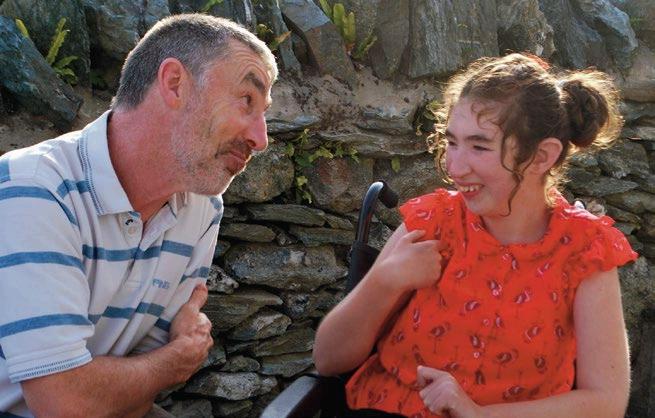

Dad Richard shares a special moment with Daisy; (inset) the children enjoy hugging
now, and they call us to tell us that he’s there.”
Richard explains, “We never expected life to be so chaotic and at times the pressure is intense. All in all though, our life is wonderful. There really isn’t very much I’d change.”
Richard, Sharon and Rosie will soon be going to Majorca on their first
proper holiday in nearly 20 years but, while the near future looks bright, longer term things remain uncertain. People with autism have a shorter life expectancy and while whatever happens will be challenging, there’s one thing you can count on: smiles will never be far away from all of their faces.
AN ANCIENT RACE
Despite what the classic chase scenes in films such as Jurassic Park would have us think, scientists now believe that the Tyrannosaurus rex couldn’t actually run. If it had tried, its legs would have broken from the force.
SOURCE: MANCHESTER.AC.UK
READER’S DIGEST 10•2017 | 61
When LifeBook Writers HEAR VOICES
To be a successful LifeBook writer, it’s essential to have the ability to capture and maintain the storyteller’s “voice” throughout the book, while keeping in mind the crucial difference between a biography and an autobiography
 Amy Iori American ghostwriter
Amy Iori American ghostwriter
In a biography, the distance is considerable between the writer and the subject, it’s possible that I might never have a conversation with the person I’m writing about. I could write the biography of someone who is still alive or someone who lived centuries ago. Either way, I would write from a third-person perspective. The story would consist of facts based on extensive research from a variety of sources, along with my own interpretations of those facts.
If you’re writing your own autobiography, you’re telling a onesided story from your own perspective. You might relate your interactions with other people, but the perceptions and interpretations would be your own. What if you’re writing someone else’s autobiography? They’re telling you the story and you’re putting it on paper.
Keeping the story focused
This is where it can get tricky, because when retelling a story, we instinctively add our own spin. Our speech patterns, opinions and colloquialisms all exert influence on the words we’re writing. When uncontrolled, the storyteller’s words become our own on the page and the original voice gets lost. The story begins to sound like us.
Language and tone
While writing the memoirs of a Second World War fighter pilot, I was faced with aircraft and flying terminology. Take this passage where he describes nearly getting shot down in France the day after D-Day:
“I sent 12 birds home for refuelling in case of another mission, and kept my flight of four going after the tanks. We knocked out two or three, an APC, and a staff car. Hopping over the hedgerow at about 300 miles per hour, at 1000 I saw a big gun having at us. I honked the bird up to maybe 100 feet or so, went directly into him, and got him. He’s out of business completely. Almost simultaneously he got me. My Jug
PARTNERSHIP PROMOTION
“You, as the writer, are responsible for making sure the reader hears the author’s voice loud and clear...”
WHAT IS LIFEBOOK?
With Lifebook you can create a private autobiography allowing you to capture your story, your memories and your family history—a precious gift to share with your family and hand down to future generations. Compiled through a series of interviews and illustrated with a variety of carefully selected photographs, LifeBook captures personal history in a collection of beautiful hardback books. A marvellous gift for the whole family; the legacy of a LifeBook project is an unforgettable journey.
snap-rolled right towards the ground like a leaf in a windstorm.”
It would have been easy to insert my own language here. “Birds” are aircraft. His “Jug” is a P-47. “A big gun having at us” is the enemy’s tank taking aim, and rather than he “honked the bird up”, he increased altitude. In this case, the voice in the narrative is recognisable as that of the storyteller by anyone who knows him.
In my experience, in order to reproduce a storyteller’s voice authentically, it has been valuable to interview and record the storyteller myself or listen carefully to the audio recording of someone else conducting the interview. Either way, as I write, I make sure to pay close attention to things such as:
• Words or phrases used repeatedly
• Sentence structure and patterns
• Jargon or slang
• Specialised terms or expressions
Above all, I must be sensitive to the tone and content being shared by the storyteller. The nature of a LifeBook project is a storyteller who is sharing personal anecdotes. No matter what emotions the stories evoke, you, as the writer, are responsible for making sure the reader of your narrative hears the author’s voice loud and clear through your words. n
FOR MORE INFORMATION
Ready to start your LifeBook journey?
Call us on 0800 999 2280 or email digest@lifebookuk.com
Johanna Basford OBE, 34, is known as “the queen of colouring”. Her intricate, hand-drawn illustrations in books such as Secret Garden, Magical Jungle and Lost Ocean have sold more than 20 million copies
If I Ruled the World Johanna Basford
Everyone would eat breakfast. My gran used to set the table the night before and breakfast was a proper family meal. The idea of a cereal bar on the go would have appalled her! Her old-fashioned ideas made sense because children who eat breakfast before school are able to concentrate better in class. I’ve worked with a fantastic charity called Mary’s Meals, which provides life-changing meals to some of the world’s poorest children. It’s a simple but brilliant idea—a meal means better education, which means a chance to break free of poverty.
I’d insist on wi-fi-free periods for all. At certain times people would have to lift their heads from their screens, stop looking at cats surfing and find something better to do. Our farmhouse in Scotland is made of granite, which acts like kryptonite for wi-fi signal. It barely reaches my studio, which means I can concentrate on my drawings without distraction.



INSPIRE | 10•2017 64
ILLUSTRATED
BY JAMES SMITH
Rapid response units would magically appear if a child was having a public tantrum. They’d be like the SWAT teams you see on TV that swoop in, put up curtains and move people along saying, “There’s nothing to see here, folks.” And then they’d give the child’s carer a nice cup of tea until the tantrum had passed.
I’d make a good news channel. I hate the rolling news channels that suck people into watching disaster after disaster. There’s so much we could be celebrating, such as random acts of kindness, baby pandas being born or long-lost relatives being reunited. People could tune in and instantly feel happy with humanity. It’d be perfect for doctors’ waiting rooms or anytime we need reminding how much good there is in the world.
Workplaces would give staff analogue tools as well as digital ones. Even simple doodling on paper gets the creative juices flowing and uses a different part of the brain than we use when working with a computer. I’d like stationery cupboards to be stocked with beautiful pens, paints and different types of paper. But absolutely no novelty erasers—they just smudge colours and ruin a picture.
I’d tell people to get gardening. But I’d remind them that you don’t need to have an actual garden to surround
yourself with greenery. I’m lucky because I live in the countryside, but just growing a window box or pots with flowers can really lift your spirits. I have loads of plants inside our house too and my little girl, Evie, helps me care for them. We talk about how things grow and get excited when flowers appear.
I’d provide colouring books for all. The wonderful thing about colouring is that you can do it anywhere and there are books for all interests, from fashion to food, architecture to typography. Colouring can promote mental well-being. We adults have many things to worry about, but taking time to colour harks back to a simpler time when we were carefree. I love hearing from people who have found their inner creativity from my books and who are calmer and happier as a result.
Bedtime stories would be mandatory. Just as breakfast is a great way to start the day, a bedtime story with your child or grandchild is a perfect end to the day. Having that special one-on-one time builds a lovely relationship at an important time in their life—when they still want to spend time with you! As told to Caroline Hutton
Johanna’s new book Ivy and The Inky Butterfly is published on October 12 by Ebury Publishing.
10•2017 | 65
BestOf British
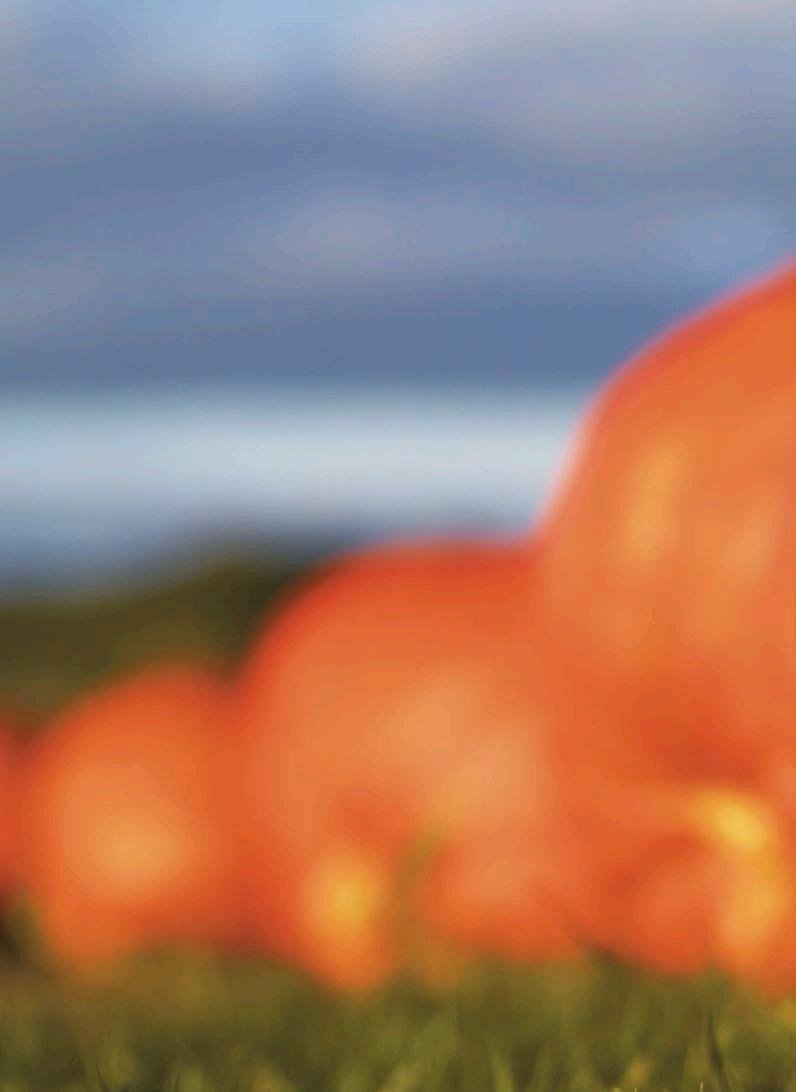
Halloween Happenings
From pumpkin picking to zombie survival runs, we uncover the best haunts for a spooky adventure
BY ANNA WALKER
OLEG MOISEYENKO / ALAMY STOCK PHOTO

INSPIRE
Pick Your Own Pumpkin KENT
It just wouldn’t be Halloween without a jack-o’-lantern glowing in your window. Strap on your wellies and find the perfect pumpkin the traditional way at this pretty, familyowned pumpkin patch.
With over ten acres of the iconic orange veg, you could bring home enough to make lanterns, pies, soups, spiced lattes and any other treats your Halloween heart desires.
Says manager Jemma Thompson, “We grow just under two million each year, so we know quite a bit about pumpkins and how to grow them!”
Hunt for all shapes, sizes and colours including the green Crown Prince and white Ghost. You need only pay for what you pick, from £1 for small squash to £4 for a “monster pumpkin”—that’s assuming you can carry it home! Throughout October. ■ Visit pickyourownpumpkin.farm for more information.




All Dogs Matter Walk LONDON
From four-legged phantoms to doggy Draculas and murderous mutts, hundreds of hounds and their owners descend on Hampstead’s haunted Spaniard’s Inn pub each year to raise money for the local dog rehoming charity shelter All Dogs Matter.
| 10•2017 68 BEST OF BRITISH
The All Dogs Matter charity rehome
London rescue dogs across the country

There’s a creepy costume contest and spooky stalls offering tricks and treats for man and best friend alike, all rounded off with a steaming bowl of pumpkin soup. And if your pooch doesn’t like fancy dress? Not to worry. There are prizes for their human counterparts too.
Says events coordinator, Rowena,
“It’s great to see so many people turning up on a misty morning to support our charity and join in a bit of Halloween fun! Look out for our witches, wizards, ghosts and ghouls across the Heath; the walk is quite a sight to behold!” October 29.
■ Visit alldogsmatter.co.uk for more information
READER’S DIGEST 10•2017 | 69 69
NATIONAL GEOGRAPHIC CREATIVE/ALAMY STOCK PHOTO
Bodmin Jail CORNWALL
Built for King George III in 1779, Bodmin Jail has held and hanged many criminals over the centuries— what better place to get in touch with ghouls this haunting season?
The “After Dark Experience” offers wannabe ghost-hunters the chance to spend the early hours of the morning in Bodmin’s darkest depths.
Beginning with a three-course meal, paranormal lovers are invited to delve into the history of this eerie site before a psychic medium leads them behind bars to encounter the “ghosts” of the former county jail.
Scare highlights include a look at the Execution Shed—a 4.5 metre-deep Victorian hanging pit. As the only one left in the UK—and a working execution site up until 1909—it’s sure to give you the heebie-jeebies. Throughout October.
■ Visit bodminjail.org for more information



Tanfield Railway TYNE & WEAR
For one weekend only, Halloween adventurers are invited to board the world’s oldest railway for a whiteknuckle ride they’ll never forget.
With creatures lurking in the dark and things going bump in the night, this family escapade will have both adults and children on the edge of their seat as witches dare you to try
BEST OF BRITISH | 10•2017 70

their potions and ghouls enrol you in gruesome games.
Says commercial director David Watchman, “Expect everything from abattoirs to forgotten forests, science experiments to zombie-infested carriages and talking pumpkins… we’ve got a lot up our sleeves! New for this year will be the haunted engine shed—would you dare walk through it? It has a few haunting stories to tell…including the tale of the headless engineer!”
Originally built sometime in the 1600s, the long history of this railway alone is enough to make your hair stand on end. October 28–29.
■ Visit tanfield-railway.co.uk for more information
Halloween Nights
CARDIFF
Experience a real “night at the museum” at St Fagans National Museum of History, where visitors make for a spooky spectacle, decked out in fancy dress and carrying homemade pumpkin lanterns to guide them around the dark grounds.
Bernice Parker, public events officer at the museum, explains, “Wales is rich with traditions and stories associated with Halloween, or Calan Gaeaf—the time when summer turns to winter. Our curators have dug into the darkest corners of the museum’s collections to find spells, songs and witchcraft that make this a uniquely Welsh affair.”
Watch a straw Wicker Man burn and walk in the lantern parade all in the spectacular grounds of this openair museum, which chronicles the history of Welsh culture through more than 40 buildings. October 29–31.
■ Visit museum.wales/stfagans for more information

READER’S DIGEST 10•2017 | 71

Zombie Survival Run
BERKSHIRE
challengers have to negotiate a five-kilometre inflatable obstacle course, but they’ll be evading live zombies.
Medals are given out to survivors for reaching the finish line unscathed
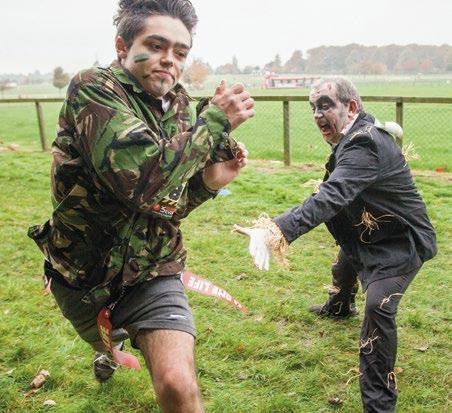
Do you scoff at the ineptitude of the humans in zombie films? Think you’ve got better survival skills? Time to prove it!
Willing victims—sorry, competitors—get lively with the undead on this booby-trapped zombie fun run. Not only do
Each runner is equipped with a tag belt decked out with three “lives”, so they can encounter three brushes with death and still make it to the end of the world… ahem…finishing line. Get through all that unscathed and you can proudly say that you’ve survived a zombie apocalypse.
You can choose to take on the course as a human, or, if you’re feeling particularly contagious, douse yourself in fake blood and enter as a zombie. October 28.
■ Visit ukrunningevents.co.uk for more information
| 10•2017 72
Events will unfold in all corners of the city for “Halloweekend”

Halloween in the City MANCHESTER
Unsuspecting tourists in Manchester are in for a scare during October—the entire city has been taken over by fright-night fever. Pumpkin lanterns will light the streets, huge inflatable monsters will invade city centre buildings and upon nightfall, the iconic Manchester Town Hall will glow a ghastly green…
The family-friendly festival, dubbed “Halloweekend”, includes a city-wide Trick or Treat, haunted mazes and the biggest “mass dress up” in Halloween history. Winning contestants will join DJs on a main stage catwalk, so be sure to dress to impress.
It’s the perfect opportunity to trick

the little ones with education wrapped up as a treat—head down to Big Fish Little Fish where bats have winged their way over from Chester Zoo and experts are at hand to explain the science of slime and spiders. Throughout October.
■ Visit halloweenmcr.com for more information
Do you have a favourite Halloween haunt? Email readersletters@ readersdigest.co.uk and tell us about it!
READER’S DIGEST 10•2017 | 73
© SHUTTERSTOCK
Many psychologists now believe that emotional intelligence is more important than IQ—both at work and at play
Choose the Path to a Happy Life
BY SUSANNAH HICKLING
GLENN HINDS WAS ANXIOUS AS HE PREPARED to play in the first round of his golf club’s singles championship. But rather than ignoring his nerves and getting on with it, as he had always done, the 50-year-old training consultant from Derry in Northern Ireland applied some of the lessons he’d just learned on a work course.
He got into his car and consciously took a moment to notice how he was feeling. This prompted a series of small realisations. “First of all, this was just a game of golf,” Glenn says. “Secondly, I wanted to win but could lose and, thirdly, the chances were that I’d get some stick from my mates. But in terms of the big picture I’d be OK.”
He was a man transformed. “My fear went

THOMAS BARWICK/GETTY IMAGES
74

INSPIRE
away and I went out there relaxed.” Not only did he win that game, but he was victorious in the next six matches and became the club champion for 2016.
and to understand what you’re feeling in a given moment,” explains Dr Edgar Bresó, a social psychologist at the Jaume I University in Spain.
It’s often assumed that women,
Emotional literacy is particularly prized in the workplace— feelings are much more important than data
Glenn was drawing on his training in emotional intelligence, the ability to perceive and manage emotions in ourselves and others. Emotional intelligence—or emotion quotient (EQ)—is a relatively new branch of psychology, first defined by US researchers Peter Salovey and John Mayer in the 1990s and popularised by psychologist Daniel Goleman in his book, Emotional Intelligence: Why It Can Matter More Than IQ. Goleman identifies several key characteristics of emotional intelligence: self-awareness (understanding our own emotions); self-regulation (staying in control); motivation (self-discipline); empathy (understanding and sharing the feelings of others); and social skills (building self-confidence).
Perhaps surprisingly, EQ has little to do with showing your feelings or with national characteristics.
“Emotional intelligence is related to the capacity to see what is happening in the face of a colleague
traditionally caring and compassionate, are more emotionally literate than men, but it’s not that simple.
“Women are stronger in empathy but men are stronger in navigating emotions,” says Maria Olsson, European regional network director of Six Seconds, a nonprofit organisation dedicated to the research and development of EQ.
GOOD EMOTIONAL LITERACY IS particularly prized in the workplace. It’s now considered that EQ, rather than IQ, is what determines success, with intellectual ability accounting for only about ten to 25 per cent of the variance in job performance.
“Knowledge on its own is not enough to be competent in today’s world,” says Dr Bresó. “Phones and PCs can provide more knowledge than you can learn in your lifetime. We’re more competent in some intellectual tasks if we’re more competent in our emotions, because when we have a clear idea about our
CHOOSE THE PATH TO A HAPPY LIFE | 10•2017
76
feelings, it’s easier to make decisions. Emotions are much more important than data.”
Studies have shown that workers with a high EQ tend to be more productive, stay in their jobs longer and earn more than their less emotionally literate colleagues. People with good emotional intelligence are more likely to be promoted, because they can identify the emotions of their superiors and continually adapt to other people.

While emotional intelligence is considered innate, many psychologists believe it can be improved. “You can train people to be more emotionally aware,” says organisational psychologist Professor Sir Cary Cooper from Manchester Business School. “You don’t either have it or not have it. It’s a continuum.”
Dutch bank ING provided EQ training for its financial markets sales staff to build trust and temper the kind of greed and fear that can lead to knee-jerk reactions on trading floors. Staff engagement was higher afterwards and sales revenue increased faster than usual.
Emotional intelligence is also helpful in the caring professions. “People in medicine, social work, nursing and clinical psychology
need to have a substantial amount of EQ to do their job effectively,” says Professor Cooper. Research in Norway, for instance, suggests that training health staff to take emotions more seriously could help prevent depression in new mothers.
BUT EQ IS ALSO IMPORTANT IN everyday life. “Good emotional intelligence makes us happier and more satisfied and offers protection against psychological problems such as anxiety and depression,” says Moïra Mikolajczak, professor of emotion and health psychology at the Catholic University of Louvain in Belgium.
She likens this protective effect to carrying a tray. “If the arm is strong—if you have good emotional
10•2017 | THOMAS BARWICK/GETTY IMAGES
77
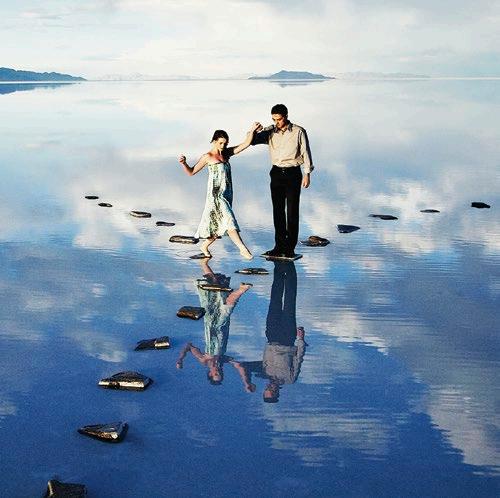
intelligence—you’re going to be able to place a lot of glasses on the tray before your arm gives way. If your emotional intelligence is weak, the slightest upset can be a problem— one glass is fine, but put another one on and...crash!”
If you don’t recognise the early signs of stress, it’s much more difficult to regulate your emotions once they’ve built up to dangerous levels. You may end up overreacting when a partner or child says or does something minor and then regretting it. If a pattern develops, it’s a recipe for unhappiness.
EQ also affects our health. Professor Mikolajczak conducted research into the effect of EQ for a large Belgian health organisation. “The higher the level of emotional
intelligence, the less medication people took, the less they went to the doctor or were hospitalised,” she says.
While a high EQ doesn’t guarantee you won’t fall ill, she says, poor emotional intelligence is much more likely to lead to poor health, notably cardiovascular and digestive problems resulting from raised stress levels.
Where emotional intelligence really makes an impact is in our relationships. “In your friendships, with your neighbours, with people you’re in contact with at the school gate, wherever you are in life, having EQ can be a really positive attribute,” says Professor Cooper.
And let’s not forget success in love. “Couples where both partners are emotionally intelligent last longer,” confirms Moïra Mikolajczak.
BEING EMOTIONALLY INTELLIGENT
also helps us bring up our children to be happier, more successful adults.
Nomeda Maraziene, a doctor and psychologist from Vilnius, Lithuania, works to boost emotional intelligence in young people in a country that has one of the highest suicide rates in the world and, according to a 2013 Unicef report, high numbers of unhappy children.
| 10•2017 THOMAS BARWICK/GETTY IMAGES
78
She begins her EQ training with the parents, teachers and other adults who act as children’s role models.
“The work of EQ starts with us as adults to increase self-awareness, optimism and inner motivation
SO HOW CAN WE BOOST OUR OWN emotional intelligence? “The most important competence is being able to perceive our own emotions,” says Dr Edgar Bresó. “So before a meeting, before selling a car, before beginning
Let’s not forget success in love—couples where both partners are emotionally intelligent last longer
because we’re responsible for the emotional content we spread around us,” she says. “It’s our responsibility to be the best possible version of ourselves in terms of attitudes, beliefs and expectations.”
Otherwise, Maraziene fears, there could be a price to pay. Egocentric behaviour is one possible outcome. “If we don’t develop children’s empathy, that could lead to isolation and an individualistic approach, which means teamwork isn’t possible.”
Maraziene recently worked with a foster centre to increase self-esteem among children who’d experienced harm and rejection. To build up their empathy and sense of responsibility, the young people helped out at a dog rescue centre, walking and caring for the dogs.
These activities bore fruit. In particular, two very withdrawn girls opened up. “They started to debate, not only talking but expressing their opinion and expanding on it.”
a task, just take a moment to think, ‘Where am I? Am I in a good place? Am I too negative or too positive?’ ”
We can also develop techniques to regulate our emotions. “If you know you’re going to get angry with your partner, just say to yourself, ‘OK, I’m going to leave the room and take a deep breath,’ ” suggests Moïra Mikolajczak. “Then go outside and do nothing for two minutes.” And she points out that for someone in a very stressful job, it could be worth taking leave at frequent intervals—for example, a week every two months.
Improving emotional intelligence doesn’t happen overnight. “It takes time and practice,” says golf enthusiast Glenn Hinds. But there’s little doubt that in today’s high-octane world, we should perhaps worry less about IQ and emphasise EQ if we want to lead a happier, healthier life.
Test your own emotional intelligence with our quiz overleaf.
READER’S DIGEST 10•2017 |
79
WWW.MINDTOOLS.COM/PAGES/ARTICLE/EI-QUIZ.HTM Evaluate each statement
actually are,
you
be.
SCORE INTERPRETATION 15-34 You need to work on your emotional intelligence. 35–55 Not bad—but you can still hone your awareness. 56–75 Great! You’re an emotionally intelligent person. SCORING How
Notatall Rarely Sometimes 1 I can recognise my emotions as I experience them. 2 I lose my temper when I feel frustrated. 3 People have told me that I’m a good listener. 4 I know how to calm myself down when I feel anxious or upset. 5 I enjoy organising groups. 6 I find it hard to focus on something over the long term. 7 I find it difficult to move on when I feel frustrated or unhappy. 8 I know my strengths and weaknesses. 9 I avoid conflict and negotiations. 10 I feel that I don’t enjoy my work. 11 I ask people for feedback on what I do well, and how I can improve. 12 I set long-term goals, and review my progress regularly. 13 I find it difficult to read other people’s emotions. 14 I struggle to build rapport with others. 15 I use active listening skills when people speak to me. For question numbers 1,3,4,5,8,11,12,15, score 1 for Not at all, 2 for Rarely, 3 for Sometimes, 4 for Often, 5 for Very Often. For question numbers 2,6,7,9,10,13,14, score 5 for Not at all, 4 for Rarely, 3 for Sometimes, 2 for Often, 1 for Very Often. 80 | 10•2017 CHOOSE THE PATH TO A HAPPY LIFE
below as you
rather than as
think you should
Then add up your score.
Emotionally Intelligent
HOW YOU CAN IMPROVE YOUR EMOTIONAL INTELLIGENCE
Psychologist Daniel Goleman identifies five elements that make up emotional intelligence.
SELF-AWARENESS
People with high selfawareness, says Goleman, are “aware of their moods as they’re having them”. Focus on the present— including how you’re feeling. And keep a diary in which you analyse your emotional strengths and weaknesses. Ask for feedback from your boss, friends and colleagues.
SELF-REGULATION
Self-regulation is about staying in control. To develop this skill, learn how to manage your emotions effectively. If you often get angry, note what triggers this feeling. Use techniques such as deep breathing to calm down, and pause before you respond to emails or requests in ways you may later regret.
MOTIVATION
When you’re distracted by your emotions, you may find it hard to see tasks through. Boost your motivation levels by developing self-discipline,
and by celebrating small wins that give you a sense of achievement. Also, set longer-term goals. When you focus on what really matters to you, it can be highly motivating.
EMPATHY
Start by thinking about other people’s viewpoints. Imagine how they may be feeling, and practice listening when they express their emotions to you. Try not to interrupt. Look at their body language. If you watch and listen to others, you’ll quickly become attuned to how they feel.
SOCIAL SKILLS
Even if you’re not a natural “people person”, it’s possible to develop better social skills. Learn how to deal with conflict and other negative situations effectively. Work on building selfconfidence. Start slowly, but then look for opportunities to practise your skills with bigger and bigger groups.
Often
Reproduced with permission of MindTools.com 81 10•2017 | READER’S DIGEST
Are You?
Very often
EXPLORING
Costa Rica
This beautiful Central American country is known for doing things differently. From its stunning array of wildlife to its approach to sustainability, it really is quite unlike anywhere else in the world—anyone who pays a visit is in for a once-in-a-lifetime experience

Costa Rica is the perfect year-round destination for nature and adventure lovers. With no true seasons, the sun shines all year and it’s unlikely the temperature will drop below 20 degrees even in the cooler months. The dry season (December–April) is the most popular but sunny days at the beach during the rainy season (May–November) aren’t unusual.
The long-standing commitment in Costa Rica to protecting wildlife and promoting green living have attracted international interest from those intrigued by its inventive—and often revolutionary— approach to sustainability.
Nature at its finest
Any visitor is immediately presented with an array of stunning scenery; lush rainforests and towering volcanoes await, while in the capital city San José, there’s a wealth of architectural and cultural treasures, including world-class museums, galleries, presidential palaces and dazzling public gardens.
The nature reserves spans over 25 per cent of Costa Rica’s land and are home to a rich diversity of wildlife—observant visitors have a chance to catch sight of some of Costa Rica’s more elusive endangered species, including sloths and jaguars.
PARTNERSHIP PROMOTION


The National parks
At Tortuguero National Park you’ll see crocodiles lurk beneath freshwater rivers, which are also home to the less intimidating green turtle. Guided boat tours are available to anyone who wants to experience this dramatic and evocative landscape.
“Costa Rica’s national park system is a network of protected rainforests, tropical dry forests, cloud forests, marine areas and wetlands”

Manual Antonio National Park is extremely diverse with nearly 200 species of birds and over 100 species of animals who call it home. Make the most of the beautiful white sand beaches, soak up the views and experience the sunset over the Pacific Ocean. The phrase “pura vida”, which means pure life, has become the unofficial motto of Costa Rica—and it’s easy to see why. The vibrancy of its thriving wildlife is mirrored in the dynamic approach of its people. Costa Rica will imbue you with a new and colourful lease on life which you will be sure to carry with you as you journey back home. n
COSTA RICA—A WORLD OF NATURE
At Arenal Volcano, visitors can journey through trees on hanging bridges that traverse the rainforest canopy. The contrast between the lava fields by the dormant volcano and surrounding verdant rainforest makes for breathtaking views.
Reader’s Digest Guided Tours are offering a 12-day tour exploring San José, Tortuguero National Park, Arenal Volcano and Manual Antonio National Park. To find out more visit readersdigestguidedtours. co.uk or phone 0800 804 8373

photo Competition Summer
Winners
See the snaps that grabbed the top spots!
ONCE AGAIN, WE’VE HAD A TRICKY TIME! Only in the best way, mind—with so many brilliant entries to this year’s competition, it’s been difficult to narrow the selection down to a few lucky winners.
Fortunately photographer James Eckersley was on hand to help. Turn the page to discover this year’s victors—and many thanks to all who entered!

INSPIRE

In association with

85

Emily Williams, from Bristol, says:
“I love taking photos of moments that show emotion. This photo is of a lady and her new baby in our local park and I was captivated watching the bond between them. It reminds me how important it is to enjoy those precious moments with loved ones.”
What our judge said:
“This is a beautiful shot, isn’t it? It makes clever use of colour and the marriage of the small subject against the big expanse of the tree just works. The combination of the blossom and the mother with her child brings hope; it’s a very emotive image.”
photo competition 86 | 10•2017
Adult Category Winner

RuNNER-uP
Guy Stirling, from East Lothian, says:
“Looking out onto the Atlantic Ocean from Gran Canaria, my sister posed as the strong waves struck the harbour wall.”
What our judge said:
“The use of colour is very strong here. The white of the water echoes the white of the clouds. Only in one little strip, leading your eye around, have you got the bright, bold colours of the buildings.”
RuNNER-uP
Philip Goacher, from West Sussex, says:
“I took my grandson Oscar, 21 months old, onto the deserted golden sands of Watergate Bay, Cornwall, at 6am—on what proved to be one of the warmest days of the year. This was Oscar’s first experience of sand, puddles and seagulls. He loved it, as did I!”
What our judge said:
“
This composition leads your eye from the bottom of the photo on a winding path up with the footprints. It’s not just footsteps in the sand—you know whose they are! The long shadows, the blue sky, the warm tones of the sand: it all says summer.”

R E ad ER ’ S dI g ES t
87 10•2017 |
Under 18s Category Winner

Morgan Gunn, 15, from Buckinghamshire, says:
“My grandfather was evacuated to Selsey during the war. My brothers, my sister and I visit the beach there frequently. It not only has great sentimental value to us, but it’s also something we all associate with summer holidays. I was concentrating on my composition here, and therefore the symmetry of the image.”
What our judge said:
“The composition of this photograph is certainly impressive. It’s cleverly done: the leading lines of the boat come in and point you straight to the horizon line. It’s almost dictating what we look at and it what order, which is very sophisticated. I also like the nearsymmetry of what looks like the lifeboat house on the left and the fishing boat on the right, which gives you a perspective and a depth of focus.”
photo competition 88 | 10•2017
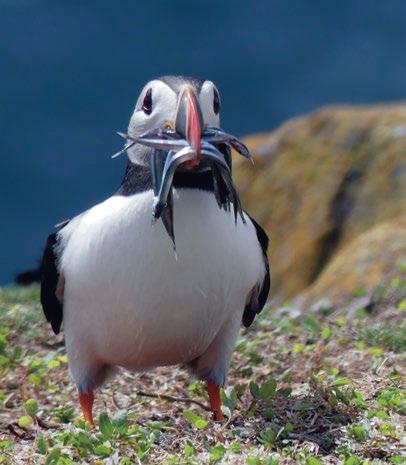
RuNNER-uP
Sami Patel, 12, from Hertfordshire, says:
“This photo was taken on Southend beach. I took it while I stood on a pier, focusing on the sun so that I could get the shadow of my father. My family love it!”
RuNNER-uP
Katy Read, 13, from Newcastle upon Tyne, says:
“The puffins come back to the Farne Islands every summer to breed, and for the last couple of years I’ve been out to see them. This one was standing where I could get on eye-level with it!”
What our judge said:
“Katy has used a very small depth of field, getting just the hint of the background so we know its location. She’s captured the moment beautifully.”
What our judge said:
“
This technique is called contre-jour —or into the light. The main subject is clearly in a silhouette, but you can see quite a lot of detail in the rest of the photograph, particularly in the water and the sky. It’s almost monotone with blacks, greys and a hint of blue.”

R E ad ER ’ S dI g ES t

The Nagaur Fort comprises temples, courtyards and palaces

In India’s Rajasthan region, the once royal families are inviting travellers to share in the high life
BEHIND THE PALACE DOORS
BY LISA ABEND
TRAVEL & ADVENTURE
91
THE MAHARAJA OF JODHPUR HAS KEPT ME WAITING. Fifteen minutes have passed since our appointed meeting time in Umaid Bhawan, his sandstone palace. With its elaborate dome rising above the city of Jodhpur, in northwest India’s Rajasthan region, it looks like the country’s version of Sacré-Coeur.
The office where I wait is panelled in dark wood, its furniture about 70 years out of date. A man whose job seems to be shuffling papers, one sheet at a time, nods a greeting. A matronly secretary steps out to offer me tea. I decline, but she returns ten minutes later to offer again. This time, I accept.
Later, the man shuffles by again with another page and glances at the skin of milk forming in my cup. “Your tea is getting cold, Madam,” he says. A fan clicks overhead. At precisely one hour past our appointed time, the secretary returns. It’s just that His Highness is so busy, you see.
The Maharaja of Jodhpur has stood me up.
I can’t quite say I’m surprised. The maharaja is merely acting like a monarch. That, after all, is what the maharajas once were: kings of the many small states that made up India. Even after Britain colonised the subcontinent, many of the royals retained their lands and influence in exchange for collaborating with the imperial government. Independence, in 1947, and the democracy that ensued were supposed to turn these former royals into ordinary citizens.
Of course, it wasn’t that simple. New laws may have diminished the riches of India’s royal families, but the
vestiges of generations of privilege and authority remain. That’s especially true in Rajasthan, where princely culture survived the longest and the land is dotted with palaces that are still occupied by families with regal roots. I wanted to understand the role of these families in present-day India and see how they navigate modern life while still embodying the old system, so I set out to traverse the region. It’s not hard to find these erstwhile monarchs—in an effort to hold on to their palaces, many have turned them into hotels.
TEN DAYS BEFORE MY botched meeting with the Maharaja of Jodhpur, I explained my mission to Sayar Singh, the man in a starched blue shirt charged with driving me around Rajasthan. It took us seven bone-rattling hours, but we finally turned the car sharply into the hushed driveway of our first stop: Raj Niwas, in the district of Dholpur.
BEHIND THE PALACE DOORS | 10•2017
92
ALL PHOTOS BY JOÃO CANZIANI
The palace was a veritable museum, a preserve of Anglophile nostalgia complete with a liveried doorman. The furniture was dark and heavily carved, the worn carpets were silk, and every inch of the walls that wasn’t adorned with Ionic columns was hung with paintings of regal men in turbans. Built in 1876 by a family that had been given Dholpur as a fiefdom, Raj Niwas was developed to house Britain’s Prince Albert on his first visit to India. His hosts wanted him to feel at home, so they designed the parlour ceiling to match the one at Buckingham Palace.
“Everyone who has a structure like this wants to preserve it,” said Dushyant Singh, the estate’s current owner. “That wouldn’t have been possible without tourism.”
A stocky, fast-talking man in his forties, Dushyant is, in his own words, “a hotel professional.” But he’s also the scion of the local ruling family, the son of Rajasthan’s chief minister and a politician himself—a characteristic that became increasingly obvious as he extolled Dholpur’s attractions. “We’re convenient to Delhi and to the Taj Mahal,” he said. “But we have excellent wildlife close by. Guests come here to relax. Have you seen our reviews on TripAdvisor?”
Dushyant wasn’t sentimental for the past. He had grown up in the palace—room “No. 6” was his childhood bedroom—but he

At the Suján Rajmahal Palace, successive maharajas chose this space as a bedroom
professed no discomfort at having strangers in his home. In fact, he had built a restaurant and modern cabanas in the palace garden in order to increase the number of guests the hotel could accommodate. Confident, with at least one eye firmly on the bottom line, Dushyant didn’t act like royalty; he acted like a venture capitalist.
MY NEXT STOP, Prithvi
Vilas, was located seven hours away and was more homestay than hotel. Maharaj Rana Chandrajit Singh and his wife, Ira— he looking like Clark Kent, she resplendent in an emerald-green
10•2017 |
93
sari—waited in the doorway to greet me with a necklace of marigolds and a glass of juice. They graciously showed me my room, an enormous chamber containing a rose petal–filled bathtub, then invited me for gin and tonics in a faded sitting room that looked like it was sinking beneath the weight of its Edwardian furniture and gilt-edged family photos. Every few minutes, a member of the serving staff in a paramilitary uniform brought us snacks.
Chandrajit, aka, the Maharaja of Jhalawar, showed me around. Leopards, tigers, gazelles, a boar— all skinned, stuffed and looking quite displeased—filled the hallways. I counted ten complete porcelain tea sets in the dining room. In the living room, he motioned to a corner table topped with a black-and-white photograph of a man with an aquiline nose. Something about the man looked familiar, so I walked over to read the inscription. “To my good friend,” it read. “With warm regards, Benito Mussolini.”
a position in town, say, or aiding a couple whose marriage has gone sour. This is how it used to be, the maharaja handling matters large and small for his people. Some residents “miss the earlier times,” Chandrajit said, “when there was a ruler to hear the problems of the public.”
RANVAS HAS A HAND-PAINTED FRESCOE OF GIRLS DANCING IN A MONSOON RAIN
Signs of those earlier times still filled Prithvi Vilas. Shelves of books, trunks crammed with photographs, cupboards packed with several generations’ worth of linens: the past encroached like kudzu swallowing a tree. But in the morning, when it came time to leave, Ira pulled me onto the sofa and whipped out her iPad. She swiped briskly through a series of photographs of modern rooms, all clean lines and sleek furniture. “It’s our apartment in Delhi,” she whispered urgently, as if trying to convince me— or herself—that she and her husband really were of this age.
AThe family left politics when, in 1967, Chandrajit’s grandfather died young of a heart attack induced, they believe, by the stress of it all. But the royal scion exercises power in other ways, too helping a teacher find
S SAYAR AND I CONTINUED driving through towns, villages and desert, we talked about the Maharaja of Jodhpur. The man I’d failed to meet was all anybody in Rajasthan seemed to discuss, because his son’s wife had recently given birth to a baby boy. In 2005, their older son had suffered a
BEHIND THE PALACE DOORS | 10•2017
94

brain injury in a polo accident and had yet to fully recover, so the birth represented not only a near-miraculous continuation of the family line but also triumph over tragedy.

The lush grounds of the Raj Niwas Palace Hotel; (right) a woman
“He doesn’t have any authority, does he?” I asked. “He’s not the maharaja anymore. Why does everyone treat him like he’s still a king?”
A smile played across Sayar’s lips. “Heredity, madam,” he said, “is stronger than any constitution.”
The mile of ramparts we passed as we entered Ranvas Nagaur, a palatial hotel within a fortress, imparted a degree of grandeur I hadn’t yet encountered. One ground-floor room
held three beds done up in red brocade and a flatscreen TV. “This is where the maharaja stays,” the manager said. There he was again: the Maharaja of Jodhpur. His hotel company owns and runs Ranvas. My residual annoyance at being ditched faded as I walked through an archway adorned with marvellous frescoes and into the uninhabited part of the palace.
Make that palaces. Ranvas is actually a 38-acre complex, part hotel and part museum, where guests can book a stay at one of ten havelis (or mansions) which, in another time, would have housed a queen. Each haveli has three to five rooms. The
10•2017 |
95
sweeping at Amber Fort near Jaipur
museum includes the evocatively named Palace of Mirrors and Palace of Lanterns, the latter of which houses upwards of 500 oil lamps. During the day, the museum complex is open to the paying public, but after 5pm, only hotel guests are allowed on the premises. Having arrived during the scorching off-season, with the exception of a guide, I had the place to myself.
The fort, which has roots as far back as the fourth century, was one of northern India’s first Muslim strongholds, but it’s rife with the keyhole arches and inlaid floors that
characterize Mughal architecture. My guide pointed to an especially fine fresco of girls dancing in the monsoon rain. “Muslim artisans painted the geometric designs and Hindu ones the figures,” he said.
“Everybody did what they were best at.” He took me up to the roof, where the sun was carmine over the town below and the sandstone ramparts glowed hypnotically. The guide interrupted my reverie. “And to think, this would have been lost without the Maharaja of Jodhpur.”

DESPITE HIS STERN demeanour, even Sayar seemed pleased with our last stop. Located on a rural road surrounded by fields outside of Jaipur, The Farm is not a palace at all. The young couple who own it, Surya and Ritu Singh, belong to the noble class. Surya’s father’s estate was submerged, literally, when the state built a hydroelectric dam nearby. His father saved all the furniture he could, put it in storage and bought a piece of land with the compensation he received. Surya and Ritu feel an attachment and responsibility to their heritage, but they’re also
BEHIND THE PALACE DOORS
A groundskeeper at Suján Rajmahal
artists (they build installations using reclaimed scrap material) who embrace the creative power of change. And so they took that land, built cottages for guests and furnished them with pieces the elder Singh had saved.
At The Farm, an old wagon has become a settee in the poolside dining area, and it isn’t uncommon to see a Dodge steering wheel functioning as a towel rack in your room. There are wedding albums filled with family photos in the downstairs library, but they’re one of the few signs of the past left intact; everything else has been reimagined.
YOU SHOULD MAKE USE OF THE EDUCATION YOU’VE BEEN PROVIDED WITH
chefs moonlight alongside the resident chef week-to-week to create innovative menus. “We know plenty of people who are still stuck in the past,” Ritu says. “They believe the Raj will come back. Even women I went to school with, the ones who were well-educated and wore jeans, they come back, put on their chiffon saris and become the maharaja’s wife. Times have to change; it’s important to speak to your culture, but you should also make use of the education you’ve been provided with.”
“Some friends who own palaces, they can’t keep them up; they’re crumbling,” said Surya. “We get to start from scratch and put the puzzle back together the way we want.”
In addition to The Farm, Ritu and Surya run an experimental restaurant called Wolf in Jaipur. There, local
But change never happens in a straight line. Democracy and modernday consumer capitalism were everywhere in India, except where they weren’t. Privilege and effort, heredity and ability, past and future were entangled in ways I couldn’t begin to understand. All I’d seen in those lovely estates was a glimpse of the knot.
DOWN IN THE DEEP BLUE SEA
An estimated 50–80 per cent of all life on earth is found under the ocean. There’s plenty of space, though, as the oceans contain 99 per cent of the living space on the planet.
SOURCE: UNESCO.ORG
10•2017 |
97 READER’S DIGEST














 BY CATHY ADAMS
BY CATHY ADAMS

Cathy has danced in Rio, been microlighting in South Africa and hiked the mountains of Oman
The Northern Lights are a natural phenomenon
My Great Escape: Aurora Borealis
Katie Sone from Leicester
glimpses the coy Northern Lights
“WE CAN’T GUARANTEE
ANYTHING—but the weather is favourable,” our guide Louisa told us in her broad Icelandic accent, rolling her Rs. I was filled with quiet trepidation as my husband and I climbed the steps to board the coach. We were dressed in thermals, jumpers, coats, hats and gloves. It was 9pm on a February evening in Reykjavik, and we were headed to see the Northern Lights.
WE WANT TO HEAR FROM YOU!
Tell us about your favourite holiday (send a photo too) and if we include it on this page we’ll pay you £50. Go to readersdigest. co.uk/ contact-us


Louisa informed us we’d be heading to the town of Reykjanesbær, to an old abandoned naval base close to the airport. It used to be a Nato operating base, but now is just a good spot for dark skies.
We disembarked, the atmosphere eerie and quiet: only a hushed chatter, the sound of feet crunching over gravel and the wobble of torches as we trampled over rough ground. We quickly separated from the group to find a good spot, treading carefully in the dark.
My husband suggested turning round and closing my eyes. Upon opening them, I saw a vast black sky bursting with bright stars. It was spectacular, but he told me to turn back around. As my eyes adjusted to the utter darkness, a faint ethereal glow in the shape of an arc appeared to grow

| 10•2017 100 TRAVEL & ADVENTURE

brighter. It was smudging across the sky, changing its shape from an arc to an S, disappearing and reappearing as I watched. It was a misty, opaque pattern of sea green, turquoise, teal; a soft light continuously moving and dancing. I gazed up at the sky for an hour, just taking in the magnificent view.
We got back on the coach after a successful sighting, basking in its warmth. But almost immediately the coach stopped and we were ushered off to an even more impressive sight: the lights were now even clearer, dazzling and swirling. It was perfect.
■ TURN ON THE LIGHT
Flights to Reykjavik start from £37.99pp with easyJet (easyjet.com).
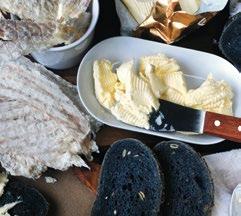

PostcardFrom....Tibet

VAST, MOUNTAINOUS TIBET is one of the highest areas of the world, and also one of most inaccessible—unless you go by train. The Golden Eagle Luxury Train uses the world’s highest railway as it weaves through Tibet and northwestern China, passing stunning landscapes, Buddhist temples and millions of yak.
Journeys on the Golden Eagle Luxury Train start from £6,895pp (goldeneagleluxurytrains.com).
10•2017 | 101
© GRAYLINE / SHUTTERSTOCK
Things To Do This Month

BANGKOK IN TWO MINUTES
■ STAY: PARK HYATT BANGKOK Bangkok’s newest hotel has all the accoutrements of a luxury urban oasis: an infinity pool overlooking the city, a stylish steak restaurant, Penthouse, and spacious, light-filled rooms. Rooms from £180 per night (bangkok.park.hyatt).
■ EAT: GAGGAN It might not be a typical dinner choice in Thailand, but Gaggan’s multi-course tasting menu spanning progressive, molecular Indian cuisine is a thing of beauty. Gaggan was voted Asia’s best restaurant in 2017 for the third year in a row (eatatgaggan.com).
■ SEE: WAT PHO The oldest temple in Bangkok—and the apparent birthplace of traditional Thai massage—Wat Pho is known for its 46-metre-long reclining gold Buddha and gilded chedis. Handily, Bangkok’s Grand Palace is a short walk away (watpho.com).
TRAVEL APP OF THE MONTH

Tripcase, Free, Android, iOS. An all-in-one app that stores flight details, hotel bookings and everything else holidayrelated. What’s more, it’ll send you flight status alerts. Useful.
SHORT/LONG HAUL: HERITAGE HOLIDAYS
SHORT: Lake District This beautiful area in north-west England has finally been awarded Unesco World Heritage status. The home of William Wordsworth and Beatrix Potter remains one of the best places in Europe to hike (ramblersholidays.co.uk).

LONG: Iran Visit all 21 Unesco World Heritage Sites in Iran, including Shiraz, Persepolis and the ancient city of Ardabil with a new tour from Travel The Unknown, which departs this month. Leave some suitcase space for souvenirs! (traveltheunknown.com).
| 10•2017 102 TRAVEL & ADVENTURE
FOR MORE, GO TO READERSDIGEST.CO.UK/ TRAVEL-ADVENTURE
© SHUTTERSTOCK







WIN THE TRIP OF A LIFETIME!

Reader’s Digest is working with Collette Travel to bring you tours across the globe that will both reignite the spark in you that craves adventure, and immerse you in the environment and culture of each country you visit.
To celebrate the launch of Reader’s Digest Guided Tours, we are o ering one reader the chance to win the trip of a lifetime for two people.

The lucky winner will pick which tour they would like to go on from the 12
featured Reader’s Digest Guided Tours on o er. All we ask is that you take lots of pictures and videos and come back and tell us and the Reader’s Digest community how amazing your tour experience was!
FOR MORE INFORMATION
■


To learn more about all our unique, sought after experiences and to build your own adventure visit readersdigestguidedtours.co.uk or phone 0800 804 8373.


PARTNERSHIP PROMOTION
Name: Address: Phone number: Email: Competition Question: Who is Reader’s Digest Guided Tours partnered with? (tick correct answer) A) Collette Travel B) Thomson C) Trip Advisor Please check this box if you are happy for Reader’s Digest to pass your details to its commercial content partner Substantive Media to send you o ers from third parties in the travel & lifestyle sectors via post and email For your chance to win, simply fill out the coupon below and post it to: Freepost RTKA-XHBE-YLRC, Reader’s Digest Travel Competition, Orbital Marketing Services Group, The Boulevard, ASHFORD, TN24 0GA. Or enter at readersdigestguidedtours.co.uk Competition closes at midnight on 20/11/17. For competition T&C’s visit www.readersdigest.co.uk
 Solo helicopter pilot, Sergey Ananov, wanted to set a world record
Solo helicopter pilot, Sergey Ananov, wanted to set a world record
The helicopter crashed into the icy waters of the Arctic Circle. Could the Russian pilot survive?
Marooned
Among
Polar Bears
BY JUSTIN NOBEL
TRAVEL & ADVENTURE
PHOTO: ©ALEXANDER GRONSKY
105
Part One
THE POUNDING NOISE SHATTERS THE SILENCE of Davis Strait, a frigid finger of ocean separating Canada and Greenland. Thwick-thwack, thwick-thwack. The noise comes from above but the marine fog is thick, the source invisible. The sound gets louder. THWICK-THWACK, THWICK-THWACK .
THE PILOT wears an old red neoprene survival suit. But after 42 days, 21,000 miles and two continents (Eurasia and North America), he sometimes has to relax a little. So he’s bare-chested, with the suit unzipped to his waist, when the sputtering begins.
The helicopter isn’t big: a plucky 400kg Robinson R22. The pilot knows what the sputtering means: a belt transferring power from the engine to the rudder blades has just snapped. He also knows what comes next. The helicopter is going down.
The pilot switches to autorotation, a safety mode that allows the craft to glide downward. From a height of 3,000 feet, it falls at roughly 50 feet per second. But falls where? It isn’t until 700 feet above the partially
frozen sea, barely enough time to manoeuvre, that the helicopter pierces the fog. The pilot aims for an ice floe, realises he won’t make it, tilts the craft for safest impact and lands the skids on the water.
The pilot knows the blades could accidentally chop off his head when he climbs out. By leaning to the left, he tips the helicopter in order to smash the blades to pieces against the sea. This kills the engine but now, tail-first, the machine starts to sink.
THE PILOT IS SUBMERGED TO THE NECK—KILLER WHALES AND THE ELUSIVE GREENLAND SHARK HUNT THESE WATERS
Freezing water floods the cockpit, wrapping around his naked chest, rushing down the legs of the unzipped survival suit. His gear begins to float—plastic fuel tanks, a bag of clothes—but the most crucial items are suction-cupped to the windshield: two GPS trackers, one distress beacon and a satellite phone. Somewhere behind his ankles there’s also a deflated life raft containing a survival kit with three flares, a half-litre of water and a tiny box of protein tablets.
Almost instantly, the pilot is submerged to the neck. There’s only time to save one thing. The phone can call for help. The beacon and GPS tracker can give rescuers
| 10•2017
MAROONED AMONG POLAR BEARS 106
a chance to actually find him. But none of those do much good if he can’t stay afloat.
He reaches for the raft, but it’s stuck. He swims out the door then dives back into the partially submerged helicopter. The water is black and salty—and about 1.5C. He frees the raft, swims to the surface and greedily gulps air.
He begins swimming to the ice floe—160 feet away. He drags the raft with one hand, uses the other to propel his 12.5-stone frame, now weighted down by the waterlogged suit, through the waves. Killer whales and the elusive Greenland shark hunt these waters.
After three gruelling minutes, he makes it to the floe. But this ice is two feet thick and rough. The weight of the suit makes it impossible to hurl his legs over the jagged lip. He keeps trying, but the sharp ice scrapes away skin, and blood runs down his forearms, into the sea. He finds a smooth section, presses his bare chest flat against the ice, uses his nails as claws and shimmies atop.
Every inch of him is soaked, and his chest is now exposed to the biting wind. He shivers violently, an automatic response intended to generate heat. His shaking hands struggle to peel off the suit. Once off, he flaps it up and down, trying to wring out the water. And it is then, in under 15 minutes since the belt snapped, as he stands on the ice floe

Marooned above the Arctic Circle, Sergey didn’t know which predators might be prowling nearby
in nothing but his running shoes and underwear, that the situation becomes clear.
Sergey Ananov is trapped on a slab of ice in the Arctic Circle. He has no locator beacon, no phone and barely any water. The fog will hide him from any rescuers. Night will come. Hypothermia will come. And whatever large, powerful creatures scratch out their existence in this primordial world—maybe they will come too.
His eyes wander over the murky open waters. With each passing minute, he’ll drift farther from where helicopter went down, lessening the chance he’ll ever be found.
10•2017 |
107 READER’S DIGEST
© SHUTTERSTOCK
Sergey in the Robinson R22 as he takes off from Providence Bay in far eastern Russia

BACK ON JUNE 13, 2015, the day his Robinson R22 lifted off from the airfield about 20 miles from Moscow, 49-year-old Sergey Ananov was the owner of a Moscow rubbish-andrecycling company. He’d already set five world aviation records in the R22 but nothing as ambitious as this: becoming the first person to fly alone around the world in a helicopter weighing less than one metric ton.
According to the Fédération
Aéronautique Internationale, there has been only one successful roundthe-world solo helicopter flight. But that was in a heavier craft and the pilot had support aircraft trailing him. Except for a couple of friends tracking his progress online, Sergey
was doing it alone. This would be the record to put him among the legends.
He began by crossing Siberia into Alaska, flew south through the western United States, then zigzagged across the American heartland. His days began at dawn and he often landed in the dark, averaging about 500 miles a flight. He refuelled at local and regional airfields. He ate mainly fast food and slept in local hotels.
Sergey got to know America, staying the night in outposts such as Sidney, Montana, and Guntersville, Alabama. The people were friendly— some gave him fuel. He entered Canada near Montreal, traversed remote Quebec and crossed the Hudson Strait to Iqaluit, capital of the Inuit territory of Nunavut.
It was from here that he took off that morning of day 42—less than 3,000 miles from home and certain glory.
Now, stranded and shivering, he allows a few minutes to beat himself up for his mistakes. If only he’d dived once more and retrieved one of the GPS trackers or the distress beacon. If only he’d managed to land on the ice floe. He could have somehow hailed a mechanic to fix the R22 and still captured the record. But none of this matters now. He gets to work.
He struggles into the dank survival suit, so he has a thick layer between him and the wind, but that layer is soaked and his body continues to shiver. He fumbles with the cord to
MAROONED AMONG POLAR BEARS | 10•2017
108
PHOTO COURTESY SERGEY ANANOV
blow up the life raft. After several yanks, the raft inflates. He ties it to his leg so it won’t blow away. Using it as a windshield, Sergey lies beneath, flat on his stomach.
This is not the teeth-chattering cold of spending too long on a ski slope. This is the cold of gangrene and cardiac arrest and brain death. Sergey gets up and tries to walk around his ice island, dragging the raft behind him, but he’s quickly panting. Nerve and muscle fibres don’t work so well in the cold. He figures the most helpful thing he can do is simply try to retain heat and energy. He lies back down under the raft.
ABOUT 3,000 MILES AWAY, in San Francisco, a Russian-American friend of Sergey’s named Andrew Kaplin is one of those tracking the journey online. Kaplin sees that one of the GPS trackers indicates the helicopter’s speed has flatlined. He makes a call to another of their pilot friends in Moscow, Michael Farikh. It’s the middle of the night there, but both Farikh and Kaplin begin calling the rescue services. Finally Kaplin manages to raise help—The Joint Rescue Coordination Centre in Halifax, Canada.
Halifax dispatches two C-130 Hercules aircraft to the pilot’s lastknown position. But it’s too late in the day for a thorough search.
Halifax also radios the Pierre Radisson, a 323-foot Canadian Coast
Guard icebreaker commanded by Captain Stéphane Julien. Though here, too, a snag. The vessel is at least a day away, escorting a freighter into Iqaluit. With no other icebreakers in the area, Captain Julien cannot abandon his charge without putting the safety of the freighter and its crew at risk.
But Julien knows how dire the
THE WIND IS UNBEARABLE. THIS IS THE DEEP COLD OF GANGRENE, CARDIAC ARREST AND BRAIN DEATH
situation is for Sergey; he can’t let the stranded pilot perish. Three hours later, once the freighter has been escorted out of the ice and can safely navigate to Iqaluit alone, the CCGS Pierre Radisson is tasked by JRCC Halifax to steam towards the last-known position of the downed helicopter, and proceeds towards Davis Strait.
SERGEY KNOWS NONE of this. He also knows nothing of the predator now tracking him...
Will Sergey make it? Read Part Two in the November edition of Reader’s Digest.
READER’S DIGEST 10•2017 | 109
6 Sociable Ways To Earn Extra Cash
Retirement doesn’t mean you should stop making money—or new friends
BY ANDY WEBB

Andy Webb is a personal finance journalist and runs the awardwinning money blog Be Clever With Your Cash
WHATEVER AGE YOU CHOOSE TO RETIRE AT, you might see two very different, but equally significant, losses. First, and most obvious, is a drop in income. If you’ve saved well, your pension will hopefully cover the essentials—if not more—but most will have far less spending power than before. The second, which is likely to be harder felt if you’re the only one at home in the day, are your colleagues. Sound familiar?
So what if I said there’s a way to boost both your income and meet people? From dog walking to focus groups, I’ve six sociable ways to earn some extra cash.
1. Walk a dog
If you’re fond of dogs, then you’ll love this chance to hang out with some pooches, and no doubt chat to other dog lovers in the park. Website Tailster acts as an in-between for you and the owner, even managing the payment process. You could earn between £8 and £15 an hour for walking, and that’s per dog. Plus you’ll be getting some exercise too!
2. Tutor a student
It helps if you’ve been a teacher as you’ll be better versed in the curriculum—useful for helping school kids ahead of exams—but there are plenty of people learning languages or taking vocational studies that you might be well equipped to
MONEY
| 10•2017 110
teach. Again there are online agencies which can pair you with students, for a cut of the fee. You can choose to visit the student, have them come to you, or even do it online via video chat.
3. Be a film extra


Ever dreamed of seeing your face on the silver screen? Well you can use your spare time to get yourself in front of the camera, even if it’s just as “woman on bus”. You’ll need to sign up to agencies (Casting Collective seems to be well regarded), and if your face fits you could earn up to £100 a day.
4. Take part in market research
One of the ways brands determine if their product is working is through focus groups. Yes, you can get paid for talking! Selection will depend on whether you fit the target demographic but, if you do, payments can range from £30 to £200 for a few hours’ “work”. Saros and Research Opinions are among the agencies worth checking out.
5. Share a skill or sell your time
There are a lot of busy professionals who don’t have the time or the skills
to do even ordinary jobs. So your years of home DIY or gardening will be very attractive to the time-poor people where you live. You can sign up to sites such as TaskRabbit where people list what they want done and you can then pitch for the work.
6. Be a mystery shopper
Not only can you get paid for this last task, you can get freebies such as meals too. Brands will pay you to test out the service you receive at their shops or restaurants, then report back on what you found. The amount you can earn per “mystery shop” won’t be huge, but expect around £5 to £15 per assignment. Use the Mystery Shopping Providers Association website to find accredited agencies.
10•2017 | 111
© SHUTTERSTOCK
My Mum’s Money
The 15-minute phone call that netted my mum £662

THIS WEEK my mum finally got around to claiming the Marriage Tax Allowance—and it’s going to make her and my dad hundreds of pounds better off.
My mum opted to call up HMRC to apply rather than via the website. Despite being put on hold, she persevered until she was put through to a real person. Then all she needed was her and my dad’s national insurance numbers. All in, it took just 15 minutes. Incredibly simple.
So who can get the Marriage Tax Allowance? Well you and your partner need to be born after April 6, 1935 and be in a marriage or civil partnership. One of you must be a non-taxpayer (usually those earning less than £11,500 a year) and the other person needs to be a Basic Rate taxpayer (ie, earn less than £45,000, or £43,000 if you live in Scotland).
If you meet the criteria you can transfer ten per cent of the nontaxpayer’s personal allowance to the taxpayer, meaning the latter can earn a little more before tax is due.
Payments can be backdated to when it launched in 2015. So my parents will get a cheque for the tax years 2015/16 and 2016/17, then for 2017/18 the allowance will be adjusted on my dad’s tax code. In total it’ll add up to £662. They’ll keep getting the tax break for future years as long as their eligibility doesn’t change.
It’s an easy win everyone eligible should be jumping to claim.

MONEY | 10•2017 112
© SHUTTERSTOCK MY MUM’S MONEY TIP: Don’t put it off. Call HMRC on 0300 2000 3300 and see if you’re entitled to the Marriage Tax Allowance
MONEY WEBSITE OF THE MONTH:
MySupermarket mysupermarket.com
IN THE AGE OF ONLINE
GROCERY SHOPPING, you don’t have to stick with whichever supermarket is nearest. Now you can choose where you buy your bananas, bread and beans based on any number of factors, including price.

The website MySupermarket will help you identify the cheapest. Select the items from your shopping list and, with just a click of your mouse, you’ll be able to see the total cost of your trolley at all the big supermarkets. Then, you can transfer your order over to the supermarket you pick, ready to select a delivery date and checkout.
There’s also a MySupermarket app which you can use when you’re out and about to check things such as price history. A useful tool if you want to make sure a special offer is the real deal.

Love Thy Wi-Fi
WHO YOU LIVE NEXT DOOR TO is now less of a worry to home movers. According to survey conducted by MoneySuperMarket, the biggest concern is being able to get back online, with more than half stressing that the wi-fi signal won’t be sufficient.
Other big concerns were:
Non-working kitchen: 40%
Weak phone signal: 37%
Who the neighbours are: 37%
READER’S DIGEST 10•2017 | 113
FOR MORE, GO TO READERSDIGEST.CO.UK/MONEY SOURCE: MONEYSUPERMARKET / © SHUTTERSTOCK
Easy-to-prepare meals and accompanying drinks
Quick Keralan Fish Curry
BY RACHEL WALKER

Rachel Walker is a food writer for numerous national publications. Visit rachel-walker.co.uk for more details
JARS OF PRE-MADE CURRY SAUCE lead people to believe that making one from scratch is unachievable. In fact, it’s remarkably straightforward. Often, making a curry does require a bit of time—but that’s not the case with a fish curry from Southern India. It comes together very quickly and makes a light and fragrant mid-week meal. Serve it with fluffy white rice, which is also wonderfully easy to prepare.
Serves 4
• 2tbsp vegetable or coconut oil
• 1 onion, finely diced
• 4cm root ginger, peeled and grated
• 4 garlic cloves, peeled and crushed
• 2tsp chilli powder
• 1tsp ground coriander
• 1tsp turmeric
• 1 large tomato, diced
• 1tsp brown sugar
• 1tbsp white wine vinegar
• 400ml coconut milk
• Salt, to taste
• 400–500g firm white fish (cod loin, pollock, tilapia, basa)
To serve: white rice (75g per person, cooked as per pack instructions)
1. Heat the oil in a shallow casserole dish or a deep frying pan, and then cook the onions on a low-medium heat until they soften and start to turn translucent. Stir in the root
FOOD & DRINK | 10•2017 114

ginger, garlic cloves, chilli, coriander and turmeric. Cook the spices until fragrant—roughly 1 minute.
2. Add the tomato, brown sugar and white wine vinegar and then cook off any liquid. Pour the coconut milk into the pan. Swill out the empty tin with a splash of water and add that too. Turn up the heat, and bring the sauce to a rolling simmer for 10 minutes, to allow it to thicken. Season with salt, to taste.
3. You might want to cut

TIP…
Like a little heat with your curry? Keep an eye out for a hot lime pickle, which sets off the dish with its perfect spiced sharpness.
the fish into bite-sized chunks, or keep the fillets intact. Either way, place the fish into the sauce, and cook until opaque and flaky. Note, the size and shape will impact the cooking times. Cod loin, for example, may need cooking for 3 minutes on each side.
Slimmer fillets or bitesized chunks will take less time.
4. Divide the rice between four bowls, and then top with the fish and sauce.
10•2017 | | 115 PHOTOGRAPHY BY TIM & ZOË
HILL
Grüner Veltliner
Fashion moves in concentric cycles: cords, flared trousers, shoulder pads. They’re in, then out, then in again. It’s funny to think that flavour can be subject to fashion too.

Earlier this year, there was an article in the London Evening Standard entitled: “9 white wines to try that aren’t Pinot Grigio or Sauvignon Blanc”—it seems that the ubiquitous whites might be heading to Room 101, along with oaky Chardonnay from the Nineties.
One of the wines recommended instead was Grüner Veltliner, for those who “like crisp fresh whites such as Sauvignon Blanc”, but are looking for something new. Already, this once-esoteric Austrian white wine is booming in popularity.
A HIP TIPPLE
Historic wine merchants Berry Bros. & Rudd, for example, have tripled the amount of Grüner Veltliner sold over the past four years.
This hip wine is (aptly) nicknamed “Gru-vey”, and is famed for pairing particularly well with foods—even tricky flavours such as asparagus. It often has a hint of white pepper, which is evident in all the bottles below, but most of all, it’s a crisp and elegant easy-drinker. It represents great value by being just off the beaten track. Here’s hoping it stays there, rather than becoming so popular that fashion condemns it as passé.
■ Domäne Wachau Grüner Veltliner Granit, (12.5%), £7.99, Lidl
■ Wm Morrison Gruner Veltliner, (12%), £8, Morrisons
■ Austrian Grüner Veltliner, (12%), £8, Sainsbury’s



FOOD AND DRINK | 10•2017 116
Mango Shrikhand

Pudding of the Month
Frozen mango is available in most big supermarkets, meaning that this exotic Indian dessert couldn’t be quicker or easier. Serve it after a curry as a way to cool and cleanse the palate.
Serves 4
• 2–3 handfuls frozen mango, thawed (or fresh!)
• 2tbsp water
• 2tbsp sugar
• 500g Greek yoghurt
• Optional toppings
• (see below)
1. Make a quick purée by putting the mango, water and sugar in a food processor, and blending until smooth.
2. Stir in the Greek yoghurt, and then divide between four small bowls. Chill for at least 15 minutes.
3. Get creative with the toppings. Keep it fresh with slices of fresh mango and mint, or embrace the exotic by sprinkling chopped pistachios and almonds or crushed cardamom seeds on top.
BOOK

Mary Berry’s Complete Cookbook, £30, DK. More than 600 step-bystep recipes for the under-confident cook.
BARGAIN

Bread Ahead, from £40, breadahead.com. There’s a course to suit everyone at this London bakery.
BLOW OUT

The Sourdough School, from £245, sourdough. co.uk. Pricey but worth it for bread-lovers.
READER’S DIGEST 10•2017 | | 117
FOR MORE, GO TO READERSDIGEST.CO.UK/FOOD-DRINK © SHUTTERSTOCK
BY LYNDA CLARK

Lynda Clark is a homes, property and interiors expert, and editor of First Time Buyer magazine
Highland Fling!
THIS AUTUMN WE LOOK TO THE HIGHLANDS OF SCOTLAND for inspiration, with soft checks and muted hues. Along with an autumnal-berry colour palette, the trend celebrates layered quilting and blankets, with plush velvet and fluffy woven wool working together to create a warm and inviting room. Stag-head prints and wall art cleverly bring the outdoors inside. This look can be as rustic or luxurious as you like—either way, it’s soft, tactile and very cosy for the winter.
Distressed black metal clock, £39; glass lantern, £9; Oliver ombre table lamp, £35; bouclé check Sherpa throw, £30; Strathmore check cushion, £16; Drumond stripe cushion, £20; Bexley duvet set, from £15; Stitch quilted throw, £25; Mirage stripe rug, from £49.
■ All available from JD Williams Home (jdwilliams.co.uk)
Get The Look
We travel over the border this autumn with these classic Scottish-inspired accessories.
■ Tweedmill wool check cushion, £25.95, black-by-design.co.uk
■ Highgrove stag print, £17, very.co.uk
■ Check bed set, £40, next.co.uk
■ Stag head lamp, £27, george.com




| 10•2017 118 HOME & GARDEN

YOUR OWN MINI-WORLD


If you’re short on space or live in a city, a terrarium is the perfect option for getting some greenery into your room. They’re easy to maintain, as they need minimal water and create their very own micro-climate. This beautiful copper Aztec Penta terrarium is available in a few options: the empty terrarium (£59.95); the terrarium with the plant (£69.95); the terrarium with the plant and lights (£79.95); or a DIY kit (£69.95)! Visit theurbanbotanist.co.uk
Jazz up your meals with these unusual plates PLATE UP




Keep your favourite London memories close to home with London Skyline plates, £35 (bl.uk/shop).

Perfect for cheese addicts! Snap up the Cheesy Love plate by Minnie Morris Art, £15 (artrookie.co.uk).

Serve cake that’s light as a feather on this plate, £6 (marksandspencer.com).
10•2017 | 119
FOR MORE, GO TO READERSDIGEST.CO.UK/HOME-GARDEN
Whether you fancy a fresh cup of coffee, a massage or just a parking spot, these gadgets have the solution...
At The Push Of A Button
BY OLLY MANN

Olly is a technology expert, radio presenter and
podcaster
PANASONIC CF-33 TOUGHBOOK, £2,627
Ever accidentally smashed a gadget on a concrete floor?
Me too—an involuntary spasm is all it takes. So there’s certainly a market for rainproof, shockproof, indestructible devices. But Panasonic’s laptop is so absurdly “tough”, it’s like lugging round a bag of bricks.
Even when divided in half, with the glove-enabled touchscreen detached to form a tablet, it’s still heavy to hold. The mouse trackpad is laggy, and the built-in fan makes an ugly whirr. Still, if you literally work on a building site, this could be your dream machine.

APPLE APP OF THE MONTH:
JUSTPARK, FREE
Enter the postcode of your destination (or search a term, such as “Bristol Station”) and this nifty app will plot out the various different parking


options available to you, and direct you there. It includes plenty of information on council-run and metered parking, but it also offers options to book reservable spaces in off-street car parks, and even on private driveways.
TECHNOLOGY | 10•2017
120
BONAVERDE BERLIN, $700
It’s rare to experience a genuine world-first, but here’s one: a coffee machine that brews one litre of fresh coffee from unroasted beans in 20 minutes. That’s right—this all-in-one gizmo actually roasts and grinds green beans, delivered straight to your door from a farm in Nicaragua, then filters them into delicious hot coffee, all at the push of a button. The sheer audacity of the concept is compelling, and of course the coffee tastes wonderfully fresh. The design is a bit clunky, and the unit is too large, but if Bonaverde flog enough of these firstgeneration models to fund a more compact iteration, I’ll be first in line.
PRYNT POCKET, £149

This little device makes printing instant photos from your iPhone idiot-proof. All you need to do is slot in a photo cartridge (a pack of 40 sheets is £20), download the Prynt app and dock your phone through the lightning connector— no wi-fi, Airplay or Bluetooth connection is necessary. It then really is as simple as allowing the printer to access your photo library, Instagram or Snapchat feed and pressing “Print”. The experience is roughly akin to an old-fashioned passport photo booth—the colours are muted, but the process is fun. The photos can be used as stickers, too.


ANDROID APP OF THE MONTH: URBAN MASSAGE, FREE
Residents of London, Manchester and Birmingham can use this app to summon a qualified, insured massage therapist. They turn up with their own massage table and oils—all you need is a couple of towels. Pick from treatments including deep tissue, sports or pregnancy. Sure, having a massage in your sitting room is a less luxurious than a treatment in a spa— but far more convenient.

10•2017 |
121
BY GEORGINA YATES

Georgina is a fashion and beauty editor for numerous travel titles and a blogger at withgeorgia.com
Water Works
THOSE WHO SUFFER FROM EXTREMELY SENSITIVE SKIN and struggle to find products that don’t cause irritation should look no further than Bioderma’s Sensibio range. The company, which was set up in the 1970s by a French pharmacist, combines biology with dermatology to create skincare that comprises only the purest natural ingredients.
The Bioderma Sensibio H2O cleansing water (£10.80 for 250ml, boots.com) is the most gentle make-up remover I’ve ever encountered—and I’ve tried a few! It contains “micelles”: a dermatological agent that’s very similar to the skin’s composition and, therefore, incredibly mild. The formula captures impurities, removing daily grime from the skin without causing any redness or discomfort. There’s a reason one is sold somewhere in the world every three seconds.

EYES ON THE PRIZE
■ The skin around the eye is seven times thinner than the skin elsewhere on your face. Another classic, the Bioderma Sensibio Eye gel-cream (£14.50, boots.com) is as light and soothing as milk and safe to use twice a day.

AUTUMN AROMA
■ Impressing noses since 1730, London perfumery Floris’ latest fragrance for women, Chypress (£80, florislondon.com), is a captivating scent of musk and creamy orange flower with a burst of light bergamot. Perfect for any occasion.

| 10•2017 122
FASHION & BEAUTY
EVERGREEN For Her

■ Sashay into the colder season in this flamenco-inspired skirt (£49.50, marksand spencer.com).
For Him

■ This evergreen shirt is the perfect smart-casual transitional piece to take you into autumn (£30, debenhams.com).
■ Wrap yourself in the colour of the season with this elegant mohair coat (£450, jigsaw-online.com).

■ A green knit jumper under a dark grey suit is an elegant autumnal combination (£47.50, whitestuff.com).


■ These moss-green boots will really grow on you (£45, debenhams.com).

■ with this shimmering viridian green watch, which is also waterproof up to 50 metres (£175, simoncarter.net).
10•2017 | | 123
Sharp storytelling and shrewd observation take centre stage in this month’s recommended reads
October Fiction
b y J AME s
WA lT o N

James writes and presents the BBC Radio
4 literary quiz The Write Stuff
Fools and Mortals
by Bernard Cornwell (HarperCollins, £20)
To adapt an old Volkswagen ad: if only everything in life was as reliable as a Bernard Cornwell novel. Thanks to the TV versions, Cornwell is probably best-known for his Sharpe and Last Kingdom series, set in the Napoleonic wars and AngloSaxon Wessex respectively. But throughout his long career, he’s proved a pro at whatever period he’s tackled—and in Fools and Mortals, he does again.

The setting this time is Elizabethan London, and our narrator is Shakespeare’s younger brother Richard—who really existed, but has been lost to history. Now he comes vividly alive as a member of his brother’s theatre company, grumbling about William’s bossiness but increasingly awestruck by his talent. As usual, Cornwell conjures up the historical background with complete conviction, throwing in lots of telling details that pull us deep into 16th-century England. But, as usual too, he also provides plenty of thrilling action—including one scene where Shakespeare turns a bit Richard Sharpe himself, giving the baddies from a rival company a ferocious and well-earned beating.
NAME THE AUTH o R
(Answer on p128)
Can you guess the writer from these clues (and, of course, the fewer you need the better)?
1. She was of French Huguenot descent.
2. She hated Alfred Hitchcock’s film adaptation of her story The Birds.
3. One of her characters dreamt of a place called “Manderley”.
books | 10•2017 124

Everything You Do Is Wrong
by Amanda Coe (Fleet, £14.99)
Amanda Coe is a highly successful TV writer, most recently with Apple Tree Yard—but her fiction is great as well. The infinite sharpness of the writing here makes for a very funny read, although not necessarily a cheerful one. In fact, the word “poor” could be applied to almost every character in the small Yorkshire town where it’s set. There is, for example, poor Harmony, a plump 15-year-old wrestling with “the impossibility of being normal”. There’s also poor Mel, a middle-aged woman who crams her life with well-meaning activity, not much of which she enjoys. Meanwhile, poor Dan, an idealistic young copper, is disappointed at the dullness of the local police work— and that nowhere in the station is there a whiteboard “with suspect and crime scene photos joined by felttipped lines”.
For most of the novel, Coe shifts with unfailing shrewdness between these and other equally touching and recognisable characters. Only in the final chapters does she perhaps lose her way, serving up a blizzard of sensational developments that, while exciting in themselves, feel like a slightly desperate attempt to disguise her uncertainty about how to end the book.
PAPERbAcks
n The Amazing Story of the Man Who Cycled from India to Europe for Love by Per J Andersson (oneworld, £9.99) Astonishing true story of the romance between an Indian untouchable and a Swedish woman. Guaranteed to have the toughest readers dabbing their eyes—even if only secretly.
n Need You Dead by Peter James (Pan, £7.99) Latest in the best-selling series featuring Brighton policeman Roy Grace. As darkly compelling as ever.
n The Age of the Horse by susanna Forrest (Atlantic, £9.99) Comprehensive history of the long, fascinating relationship between humans and horses.
n Leave Me by Gayle Foreman (simon & schuster, £8.99) Affecting novel about an exhausted wife and mother

© SH utter S t OC k
A new biography promises a balanced view of Princess Margaret—and the reputation that succeeds her RD’s REcoMMENDED READ
A Royal Rebuff
Most Royal biog R aphe R s, argues Craig Brown (right), are either “fawners” or “psychos”. The fawners pepper their books with words like “radiant” and “gracious”, while praising their subjects to the skies. The psychos take great delight in showing—or inventing—as many flaws as possible.
Happily, Brown himself falls into neither category, despite the fact that he’s tackling the Queen’s famously controversial sister. With the aid of some hairraising anecdotes, he leaves us in no doubt that Princess Margaret’s reputation for haughtiness was well deserved. On the other hand, he can’t help extending a certain sympathy towards a woman who


was never quite sure what she was for—and who, he suggests, was often at least as sneered at as sneering.
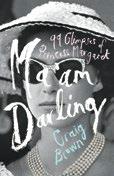
Ma’am Darling: 99 Glimpses of Princess Margaret by Craig Brown is published by Fourth Estate at £16.99
Ma’am Darling examines the key events of Margaret’s life with thoughtful scrutiny, including her early relationship with the divorced Peter Townsend that her family pressurised her to renounce, and her grisly marriage to Anthony ArmstrongJones. On the face of it, the couple were at the epicentre of Sixties jet-set glamour. Behind the scenes, there were infidelities on both sides—and rancorous rows. At one point, Tony wrote her a note headed, “Twenty Four Reasons Why I Hate You”.
| 10•2017 126 BOO k S
Brown is equally good on Margaret’s glory days as the guest of honour at parties and on her inescapably sad later years. Here she is, though, in her haughty pomp…
She had a thirst for the putdown, particularly where food and drink were concerned.
Kenneth Rose, the biographer of King George V, recorded her curt response when Lord Carnarvon offered her a glass of his very rare and precious 1836 Madeira: ‘Exactly like petrol.’ The author Christopher Simon Sykes remembers her arrival at his parents’ house one teatime. Full of excitement, the staff had prepared a scrumptious array of cakes, scones and sandwiches. The Princess glanced at this magnificent spread, said ‘I HATE tea!’ and swanned past.
In the 1980s she visited Derbyshire to open the new district council offices in Matlock. Among those on hand to receive her was Matthew Parris, at that time the local Conservative MP. ‘It was 10am,’ he recalled. ‘I drank instant coffee. She drank gin and tonic.’
Having opened the offices, she was driven to the north of the constituency to open some sheltered bungalows for old people. A dish of coronation chicken had been specially cooked for her. ‘This looks like sick,’ she said.
The mighty and the glamorous
MoRE FRoM MA’AM DARLING
When exactly did Margaret first show signs of being the world’s most difficult guest? By the age of 28 she had already developed a reputation: when Cynthia Gladwyn, the wife of the British ambassador to France, heard that the Princess would be accompanying the Queen Mother on a visit, she felt very put out.
Lady Gladwyn could not have been aware of an unfortunate incident a few days before. On the morning of a lunch in Rome held in the Princess’s honour, the ten-year-old daughter of a senior British diplomat had been taught to say grace. But when the big moment came, she grew tongue-tied. While the Princess and everyone waited expectantly, the little girl whispered to her mother that she had forgotten what to say. ‘You remember, darling,’ replied her mother encouragingly. ‘Just repeat what Daddy and I said before lunch.’
‘Oh God, why do we have to have this difficult woman to lunch,’ piped up the little girl.
10•2017 | 127 R EADER ’s Di GE s T
‘‘
were by no means excluded from these rebuffs. In 1970 the producer of Love Story, Robert Evans, and its star, his wife Ali MacGraw, flew to London to attend the Royal Command Performance in the presence of the
warned them that Princess Margaret would be among the guests. Before the royal arrival, the marquis instructed them in royal protocol. ‘We were tipped off to stand if she stood, and to call her Ma’am. Fine,
The Princess ignored Twiggy—at that time one of the most famous women in Britain—until the very last moment
Queen Mother and Princess Margaret.
‘All of us stood in a receiving line as Lord Somebody introduced us to Her Majesty and her younger daughter. It was a hell of a thrill, abruptly ending when the lovely princess shook my hand.
‘“Tony saw Love Story in New York. Hated it.”’
It was almost as though, early in life, she had contracted a peculiarly royal form of Tourette’s Syndrome, causing the sufferer to be seized by the unstoppable urge to say the wrong thing. When the model Twiggy and her then boyfriend, Justin de Villeneuve, were invited to dinner by the Marquis and Marchioness of Dufferin in the 1960s, their hostess

AND THE NAME oF
THE AUTHoR is… Daphne du Maurier. “Last night I dreamt I went to Manderley again” is the opening line of Rebecca
no probs,’ recalled de Villeneuve.
Sitting close to the Princess, de Villeneuve was shocked to find that her smoking was seamless. ‘When we started to eat, she lit a ciggie and then continued to chainsmoke, lighting one ciggie off another, throughout the meal. Where’s the protocol in that?’
The Princess ignored Twiggy—at that time one of the most famous women in Britain—until the very last moment. She then turned and asked her what her name was.
‘Lesley, Ma’am. But my friends call me Twiggy.’
‘How unfortunate,’ replied the Princess, and turned her back on her once more.
At this point, Lord Snowdon, never the most loyal husband, leaned over towards de Villeneuve. ‘You will get this with the upper classes,’ he sighed.
‘Well, I think it’s a charming name,’ chipped in the Marquis of Dufferin.
| 10•2017 128 BOO k S
’’
Books
THAT CHANGED MY LIFE

Prisoners of the Sun
BY HERGÉ
Anthony Horowitz is the author of the Alex Rider teen spy series as well as TV shows such as Midsomer Murders and Foyle’s War. His latest book, The Word Is Murder, is out now.

Stuck in a depressing boarding school, surrounded by abuse of one kind or another, I found my escape through this book’s colourful pages. At ten I wasn’t a strong reader, yet Tintin took me somewhere extraordinary, travelling through secret passages to mysterious empires and meeting endless exotic characters. It taught me how powerful a well-told story could be—and it was then that I decided to be a writer.
Great Expectations
BY CHARLES DICKENS

Strangely I read this while staying at the British embassy in Istanbul—it was a gloomy, Gothic building and turned out to be the perfect place for reading Great Expectations. I’d had to read
Hard Times at school and that had rather put me off Dickens, as I fear it does many children. This entirely different novel changed my opinion; it took me through a huge range of emotions, from the terror of Pip and Magwitch’s first meeting to the desperately sad ending. The vividness of the writing fired my imagination and has profoundly affected my work.
The Rise and Fall of the Third Reich
BY WILLIAM L SHIRER

Shirer’s study of how nationalism can be used for evil is presented as a straightforward, factual account of Hitler’s rise to power—and how it all went wrong. He shows in brilliant detail how an idea can grab a nation before people even notice they’re being led down a terrible path. With the extreme beliefs around us today, Shirer’s account seems more relevant than ever. As told to Caroline Hutton
10•2017 | 129
FOR MORE, GO TO READERSDIGEST.CO.UK/BOOKS
You Couldn’t Make It Up
Win £50 for your true, funny stories! Go to readersdigest. co.uk/contact-us or facebook.com/readersdigestuk
MY FOUR-YEAR-OLD SON had what he thought was a brilliant suggestion when we were moving house. He was worrying about the long journey the goldfish would have to make.
“Put him in the freezer, Mummy,” he suggested. “And then take him out before we go, and his water won’t spill in the van!”
VANESSA SMITH, Flintshire
I WAS TRAVELLING to work on the bus, which was crawling along the road in heavy traffic. An exasperated passenger shouted to the driver, “Can’t you go any faster?”

“Please, before we continue, do you have any social networks? Tell me so I can add you.”
The driver promptly shouted back, “Yes, but I’m not allowed to leave the bus!”
clap my hands and, sure enough, he would stop.
EMMA ALDEN, Bristol
MY HUSBAND SNORES very loudly and one day I complained to a friend about always having disturbed sleep. She suggested I make a loud noise to wake the offender and stop the incessant racket.
I decided to take her advice, so whenever the noise started I would
When I mentioned to him one morning that he’d been snoring loudly he quickly retorted, “That’s nothing, you’ve been applauding vociferously in your sleep!”
LIZ TUBBY, Norfolk
AS OUR PET RABBIT, Trigger, needed to get his teeth cut, we took him to the vet. It was a sunny day
CARTOON:
| 10•2017 130 FUN & GAMES
GUTO DIAS
and the vet’s waiting room was full of people sitting with their pets.
My then five-year-old son was looking around at all the different animals as we waited to be seen.
“Is the big dog here to see the vet?” he asked. “Is the fluffy cat here to see the vet?” Then, as a bluebottle flew in through the open window, “Is the fly here to see the vet?”
SARAH HARDING, Tyne and Wear
I TOLD MY CHILDREN that they shouldn’t tell each other to “shut up” because it was hurtful, and instructed them to find a more creative way to express their feelings.
Later that day they got into an argument and I overheard one daughter say to her sister, “Your volume needs to go off!”
MAXINE COOPER, London
I HEARD MY SON CRY out in his bedroom and I rushed over to see what had happened.
“I banged my toe, Mummy,” he cried, rubbing it. “You know, the one that ate roast beef.”
AMBER JACOBS, Cheshire
AT THE SUPERMARKET checkout, the cashier was having trouble finding the price for the cucumber I was buying, so I said helpfully, “Maybe the list is alphabetical.”
To my surprise he started searching from the bottom of the list, “Q…Q…Q…!” CELINE WILLIAMS, London
I THOUGHT I WAS doing a good job teaching my Italian students English until one recently sent me a postcard thanking me and promising, “I will forget you.”
KENDRA AITKINS, Merseyside
MY FATHER ASKED a railway official, “Does this train stop at Dover?”
He retorted sarcastically, “Well if it doesn’t, there’s going to be one hell of a splash!”
DAISY TRUBY, Hertfordshire
A GOOD FRIEND OF MINE took part in an intensive boot camp where the man in charge was extremely demanding. They were due to go on a ten-mile march on the first day. My friend started enthusiastically and after five miles was very pleased with himself, until he heard the words, “Right, men! The march will now begin!”
CATHERINE HISCOX, Hertfordshire
I WAS DOING SOME SHOPPING in my local supermarket at the same time a group from the nearby junior school were being shown around. An announcement was made over the tannoy which asked, “Will Amber please go to the deli counter straight away.”
“Can we have a go?” clamoured the children, clearly impressed.
The manager handed a small lad the microphone. He held it and confidently said, “When you have been to the toilet you must wash your hands before touching food.”
ANDREW BERRY, Lincolnshire
READER’S DIGEST 10•2017 | 131






As a print subscriber, you’re helping Reader’s Digest—still the largest circulating paid-for magazine in the world—continue to enlighten, educate and entertain readers the world over with content you can trust
Why not explore some of the great o ers and services on our website and discover even more benefits by being part of the Reader’s Digest community?
www.readersdigest.co.uk
DATING
Say hello to love! with Reader’s Digest Dating
A seamless dating experience for mature singles looking for companionship or more. readersdigestdating.co.uk
PROPERTY
Sell your home the easy way... with Reader’s Digest Property
Sell your house for cash, in a hassle-free process and on a timescale to suit you.
readersdigest.co.uk/property
EQUITY RELEASE
...or release some of its value with Reader’s Digest Equity Release
The easy way to free up the funds from your house to change your life, and keep your home.
readersdigest.co.uk/release
CRUISES
Sail away into the sunset with Reader’s Digest Cruise Club
Join the club for free for access to a dedicated consultant and bespoke cruise packages.
readersdigest.co.uk/cruiseclub
INSURANCE
Protect your property... with Reader’s Digest Insurance
Get peace of mind with an insurance product tailored to suit your needs.
readersdigest.co.uk/money/insurance
LEGAL
...and your rights with Reader’s Digest Legal
From making a claim to writing your will, we have the informed advice you need.
readersdigest.co.uk/legal
ank you for supporting
Word Power
Do you ever deploy an impressive-sounding word at a cocktail party only to wonder, Did I get that right? The terms in this month’s quiz, inspired by the book You’re Saying It Wrong by Ross and Kathryn Petras, will make you sound like the cleverest person in the room—if your pronunciation is correct. See the next page for answers.
BY EMILY COX & HENRY RATHVON
1. detritus n —A: subtracted amount. B: debris. C: falsified or dishonest claim.
2. prerogative n —A: educated guess that’s correct. B: first choice. C: special right.
3. segue v —A: transition. B: completely surround. C: begin a court case.
4. hegemony n —A: domination. B: smooth blend. C: large family.
5. dais n —A: group leader. B: miniature garden fountain. C: raised platform.
6. kefir n —A: verbal skirmish.
B: fermented milk. C: precise painting technique.
7. peremptory adj —A: allowing no disagreement. B: coming first.
C: walking quickly.
8. quay n —A: wharf. B: small island. C: dram of brandy.
9. machination n —A: robotics.
B: talkativeness. C: scheme.
10. slough n —A: soft breeze.
B: heavy club. C: swamp.
11. spurious adj —A: hasty.
B: fake. C: livid.
12. nuptial adj —A: just starting.
B: relating to marriage. C: present during all seasons.
13. coxswain n —A: innkeeper.
B: secret lover. C: sailor in charge.
14. geoduck n —A: earth tremor.
B: wooden footstool. C: large Pacific clam.
15. plethora n —A: person not of noble rank . B: abundance.
C: spiritual journey.
IT PAYS TO INCREASE YOUR
10•2017 | 133
Answers
1. detritus (dih-'try-tuss)—[B] debris. “People on our street are still picking up detritus from Billy’s birthday bash.”
2. prerogative (prih-'rah-guh-tiv)— [C] special right. “If Dad wants to regift his dinosaur tie, that’s his prerogative.”
3. segue ('sehg-way)—[A] transition. “But enough about you; let’s segue to the topic of snakes.”
4. hegemony (hih-'jeh-muh-nee)— [A] domination. “Brian has complete hegemony over this Monopoly board.”
5. dais ('day-iss)—[C] raised platform. “The crowd threw tomatoes at the dais as the mayor began her press conference.”
6. kefir (keh-'feer)—[B] fermented milk. “Beth always eats the same breakfast: kefir mixed with nuts and fruit.”
7. peremptory (puh-'remp-tuhree)—[A] allowing no disagreement. “ ‘I am not going to bed!’ the toddler shouted in a peremptory tone.”
8. quay (kee)—[A] wharf. “Passengers waiting on the quay prepared to board the ferry.”
9. machination (ma-kuh-'nayshun)—[C] scheme. “Despite all his machinations, Wile E Coyote can’t catch Road Runner.”
10. slough (sloo)—[C] swamp. “The slough is home to a variety of species, including salmon, ducks, and otters.”
11. spurious ('spyuhr-ee-us)— [B] fake. “So that UFO sighting in Hyde Park turned out to be spurious?”
12. nuptial ('nuhp-shuhl)—[B] relating to marriage. “I’ve attached a string of tin cans to the nuptial sedan.”
13. coxswain ('kahk-suhn)—
[C] sailor in charge. “It’s traditional for a winning crew to toss its coxswain overboard after the race.”
14. geoduck ('goo-ee-duhk)—
WORD OF THE DAY*
[C] large Pacific clam. “A geoduck can weigh over ten pounds—and live for more than 150 years!”
INVIDIOUS
Unjust or offensive.
Alternative suggestions:
“When the invitation card looks hideous.”
“Feeling jealous of those who can become invisible.”
“A person who’s passionate about VHS tapes.”
15. plethora ('plehthuh-ruh)—[B] abundance.
“Joe claims a plethora of proof that Bigfoot exists.”
VOCABULARY RATINGS
9 & below: mumbling
10–12: well-spoken
13–15: eloquent
WORD POWER | 10•2017 134 *POST YOUR DEFINITIONS EVERY DAY AT FACEBOOK.COM/READERSDIGESTUK

Bathmate’s MAGIC Air-cushion! Bathmate is the safest, simplest way to enjoy a proper bath - anytime, anywhere. Bathmate’s UNIQUE air-cushion forms a comfortable seat and back rest. Name Tel No. Address Postcode 0800 072 9898 Visit www.nationwide-mobility.co.uk or write to Freepost Nationwide Mobility For a FREE brochure FREEPHONE ASK FOR EXT 76470
Over 40,000 sold
Suits most baths, even small ones
No installation required Then lie back safely and luxuriate... IN RELAX Deflates... easing you gently down... 76470 At the touch of a button...up and safely out... OUT TRY IT FOR YOURSELFFREE HOME DEMO For more information and a FREE colour brochure return this coupon to Freepost Nationwide Mobility
l
l
l
Brainteasers
Challenge yourself by solving these puzzles and mind stretchers, then check your answers on p139.
Time For DesserT
Mario wants to make a parfait with exactly five layers. He has eight ingredients from which to choose: yogurt, bananas, walnuts, strawberries, custard, granola, caramel and whipped cream. Without using the same ingredient for more than one layer in the same parfait, how many different parfaits could he make? (Consider a dish with the same five ingredients layered in a different order to be a different parfait.)
Who’s in CharGe here?
At Logicapuzzle Inc., the positions of CEO, engineer and programmer are held by Anna, Belén and Cathy, but not necessarily in that order. The CEO never lies, while the engineer and the programmer are born liars. In fact, they never tell the truth! Here’s what each one said this morning:
Anna: I never lie.
Belén: Anna told you the truth— she never lies.
Cathy: Anna always lies.
Who’s the CEO?
FUn & Games | 10•2017 136
?
CEO
(Tim E f O r D E ss E r T , Wh O ’s in Charg E hE r E ?) m ar CE l Dan E si E ngin EE r Pr O gramm E r
BloCk BUilDer
How could you rearrange the twodimensional diamond shapes below— currently arranged to represent four cubes—to represent one cube?
animal hoUse
How many pets live in my house if all of them are snakes except two, all are hamsters except two and all are rabbits except two?
PaTh PUzzle
Draw a path that goes from the opening at the top of the grid to the opening at the bottom. As the path winds from one cell to the next, it can move up, down, left or right but not diagonally. It cannot pass through any cell more than once. The numbers next to the grid tell how many cells the path must pass through in the corresponding row. If a row has no number, then the path may pass through as many or as few cells as you like.
10•2017 | 137 4 1 3 1
h Puzzl E )
ri
k k im B all
(Bl OC k Buil DE r) Darr E n r ig B y; ( a nimal hO us E ) m ar CE l Dan E si; (Pa T
rODE
C
brain teasers CrossWise Test your general knowledge aCross 09 Cinema attendant (9) 10 Style of furnishings (5) 11 Take permanent possession of (5) 12 Slip worn under a dress (9) 13 Eyesight problem (7) 15 Quite mad (7) 16 Yielding to pressure (8,5) 20 Medical term of lockjaw (7) 22 Exclusively (6) 24 Circular tour (5,4) 25 ID tag (5) 26 Surly pessimist (4) 27 Biro (9) DoWn 01 Of the country (6) 02 Much obliged! (5,3) 03 Essential point (4) 04 Imaginary perfect place (6) 05 Radical, reforming (4,4) 06 Supplementary (10) 07 Confront (6) 08 Keep from harm or injury (7) 14 Dish popular in Chinese restaurants (6,4) 17 Etch deeply (8) 18 Decorative bookplate (2,6) 19 Appeal to (7) 21 Wilful school absentee (6) 22 Pliable (6) 23 One of the seven deadly sins (5) 25 Run in slow strides (4) | 10•2017 138 serWans :crossa 9 Usherette 10 Decor 11 nnexa 12 Petticoat 13 Myopia 15 diotici 16 ucklingb Under 20 etanust 22 olelys 24 oundr ript 25 Label 26 Cynic 27 allpointb :ownD 1 uralr 2 hankt You 3 Crux 4 Utopia 5 Left Wing 6 dditionala 7 ccosta 8 Protect 14 Peking Duck 17 nscribei 18 xe Libris 19 ttracta 21 ruantt 22 upples 23 loths 25 Lope 6 3 1 2 9 19 5 24 26 27 4 15 22 10 7 8 21 11 20 13 16 14 12 17 25 18 23
£50 Prize qUesTion
answer published in the november issue
Here is a wall made from building blocks. at the moment, all the blocks are white. How many colours of paint would you need if all the blocks are to be repainted in such a way that no block is touching a block of the same colour? 0
the first correct answer we pick on september 28 wins £50!
email excerpts@readersdigest.co.uk
ansWer To sePTemBer’s Prize qUesTion
an octagon. each shape has the same number of sides as the two shapes below it. if the number is over 10, then the last digit is used instead. For example, 9 + 8 = 17 so the brick above
is 7-sided. the top shape is an 8-sided octagon because there are two 4-sided shapes below it.
anD The £50 Goes To… John renel, north Yorkshire
Brainteasers: Answers
Who’s in CharGe here?: Cathy.
BloCk BUilDer: PaTh PUzzle:
animal hoUse: One of each, for a total of three.
r ea D er’s Di G es T 10•2017 | 139
4 1 3 1
has 8 x 7 x 6 x 5 x 4 different choices
Time For DesserT: 6,720. Mario
.
Laugh!
Win £50 for every reader’s joke we publish! Go to readersdigest. co.uk/contact-us or facebook.com/readersdigestuk
ABOUT A MONTH BEFORE he died, my grandfather covered his back with lard. After that he went downhill very quickly. COMEDIAN MILTON JONES
help anymore. So I go to my kitchen and close all the jars extra tight, so only I can open them.
COMEDIAN KANAN GILLS
IT’S SO WEIRD THAT Americans say “eggplant” when they’re actually called chickens.
COMEDIAN IAN SMITH
AS MEN, WE FEEL MANLIEST when we’re helping women. The problem is that women don’t really need our
WINGING IT
MY STEPDAD doesn’t like it when I call him my “fake dad”. He prefers “faux pa”. COMEDIAN GLENN MOORE
WHAT DO YOU GET if you pour boiling water down a rabbit hole?
Hot, cross bunnies. JOHN WARD, Newport
$10,000
...was the total cost of damages wreaked by 20-year-old Daniel Pimentel on the Juicy Wingz eatery in California, after ingestion of a particularly spicy wing caused him to remove his clothes and tear around the restaurant.
Source: munchies.vice.com
FUN & GAMES | 10•2017 140
© SHUTTERSTOCK
HAVING A CHILD WITH allergies is like forgetting your phone in the bathroom. “Great, now I have to read the labels on everything.” SEEN ONLINE
AS I HAVE FIVE BOYS, I thought it was important to take out a good life insurance policy. I didn’t think it would impact my birthday gifts like it did. “Wow, skydiving lessons! Guys, between that and the plane ticket to Yemen, I don’t know what to say…”
COMEDIAN DAVE COOPERMAN
STUDENTS THINK THAT university is going to be all sex, drugs and rock ‘n’ roll. Whereas the reality is more kind of, “Did you take my milk?”
COMEDIAN RUSSELL HOWARD
I ATE A SALAD FOR DINNER. It was mostly croutons and tomatoes. Well, one big, round crouton covered with tomato sauce. And cheese. I ate pizza.
COMEDIAN KEVIN HART
THERE’S A SCENE in Superman where people shout, “It’s a bird.”
“It’s a plane.”
“It’s Superman.”
In order for that scene to work, there has to be a guy who saw what he thought was a bird, and still felt the need to share that information with everyone around him.
COMEDIAN JOHN MICHAEL CRONIN
I LIKE RICE. Rice is great if you want to eat 2,000 of something. SEEN ONLINE
SURF’S UP!
Competitors partake in the eighth annual Surf Dog Competition in California (seen at buzzfeed.com).




READER’S DIGEST 10•2017 | 141
I ENJOY DOING COMEDY more now that my life is so busy and hectic. With stand-up, I know I can just go out, relax and enjoy the silence.
ACTOR STEVE MARTIN
A MONTH AFTER Donald McDougal started at Harvard, his mother called. “And how are the American students, Donald?” she asked.
“They’re so noisy,” he complained. “One neighbour endlessly bangs his head against the wall, while another screams all night.”
“How do you put up with it?”
“I just ignore them and play my bagpipes.” SEEN ONLINE
I HAVEN’T SLEPT for ten days. Because that would be too long.
COMEDIAN MITCH HEDBERG

IF PROFESSOR DUMBLEDORE did an episode of Cribs in Hogwarts, he could say “this is where the magic happens” in every room. SEEN ONLINE
I HATE DREAMING. Dreaming is work. There I am, lying in my comfortable bed. Beautiful. Next thing you know, I have to build a gokart with my ex-landlord. SEEN ONLINE
A HOMELESS MAN knocks on the door of the St George and the Dragon pub. The landlady answers. “Could I have something to eat?” he asks.
“No!” yells the woman, slamming the door in his face. A few minutes later, he knocks again. “Now what do you want?” the woman asks.
“Could I have a word with George?” SEEN ONLINE
GET THE MESSAGE?
The people of Twitter share the times they seriously failed to communicate:
@JimmyFallon: “Once I texted my friend ‘TTYL.’ He asked what it meant and I said, ‘Talk to you later’. He replied, “Jeez, just asking.”
@Shoholajc: “Asked my mum to send a pic of my dad. Five days later I got a photo in the post.”
@HannahEStrother: “My sister accidentally texted her ex-boyfriend that she wished ‘nothing but the bed’ for him and his new girlfriend.”
@JimmyFallon: “Friend was texting his mum when a restaurant texted him to say his table was ready. He accidentally replied, ‘Thanks, love you.’ ”
@Mc_Arthur123: “Texted ‘I hate migraines.’ Autocorrected to ‘migrants.’ ”
LAUGH | 10•2017 142
60-Second Stand-Up
We chatted to the king of one-liners,
WHAT’S YOUR FAVOURITE OF YOUR OWN JOKES?
I was walking along the other day and on the road I saw a small, dead baby ghost. Although, thinking about it, it might have been a handkerchief.
WHAT’S THE BEST PART OF YOUR CURRENT SET?
I’m working on a giant costume of Great Britain with a detachable Scottish head. You can probably guess where that’s going…
WHAT’S YOUR MOST MEMORABLE HECKLE EXPERIENCE?
Once somebody simply shouted, “What is this?” It was such an existential question. Did they mean life? Did they mean the show? What I’d just said? I burst out laughing because it was far too big a question for my small show.


The first job I ever had was washing dishes at an international radar station. The dishes were a lot bigger than I thought they’d be.
DO YOU HAVE ANY FUNNY TALES ABOUT A TIME YOU BOMBED?
I did the Cardiff Retail Awards recently and just before I went on, the organiser said, “You know they don’t speak English, don’t you?”
So I did half an hour to the sound guy laughing—and 300 people just staring at me.
IF YOU COULD BE A FLY ON THE WALL, WHERE WOULD YOU BE?
I’d be there when the man who invented self-defence was knighted by the Queen with a sword.
Milton Jones is touring his new show, “Milton Jones Is Out There”, across the UK until December 16. Tickets available at miltonjones.com
READER’S DIGEST 10•2017 | 143
FOR MORE, GO TO READERSDIGEST.CO.UK/LAUGH
Beat the Cartoonist!

Think of a witty caption for this cartoon—the three best suggestions, along with the cartoonist’s original, will be posted on our website in midOctober. If your entry gets the most votes, you’ll win £100
Submit to captions@readersdigest.co.uk or online at readersdigest.co.uk/caption by October 13. We’ll announce the winner in our December issue.
August’s Winner

It seems to be going from bad to worse for our cartoonist! This month, his caption, “Have you thought about possible further education?”, landed just four per cent of the votes.
The winner, by contrast, won a highly respectable 39 per cent of the votes. Niki Clifton’s crowdpleasing caption was, “Hi Dave, just popped in to ask if you fancied going clubbing after work?” Congratulations, Niki, and thanks to all who entered.

Interview: Lord Jeffrey Archer
The novelist on politics, cricket and success.

Return to Flanders Fields
Discover how DNA analysis is reuniting families with their long-lost relatives.
• The Annual Christmas Gift Guide
• 100-Word-Story Competition Launch!
| 10•2017 144
IN THE NOVEMBER ISSUE Plus
CARTOONS: JAMES GRIFFITHS (TOP) / STEVE JONES




































EQUITY RELEASE Want to release the money tied up in your home? Be sure to download our trusted guide readersdigest.co.uk/release readersdigest.co.uk/release For a FREE instant calculation call: 0800 029 1233 This is a Lifetime Mortgage. To understand the features and risks, ask for a Personalised Illustration. Reader’s Digest Equity Release is a trading style of Responsible Life Limited. Only if your case completes will Responsible Life Limited charge an advice fee, currently £1,295.













































 Fiona Hicks
Fiona Hicks






















 BY DAN MITCHELL
BY DAN MITCHELL































































 The Reverend Richard Coles attends the Cheltenham Literature Festival in 2015
The Reverend Richard Coles attends the Cheltenham Literature Festival in 2015















































 Amy Iori American ghostwriter
Amy Iori American ghostwriter













































































 Solo helicopter pilot, Sergey Ananov, wanted to set a world record
Solo helicopter pilot, Sergey Ananov, wanted to set a world record
































































































































